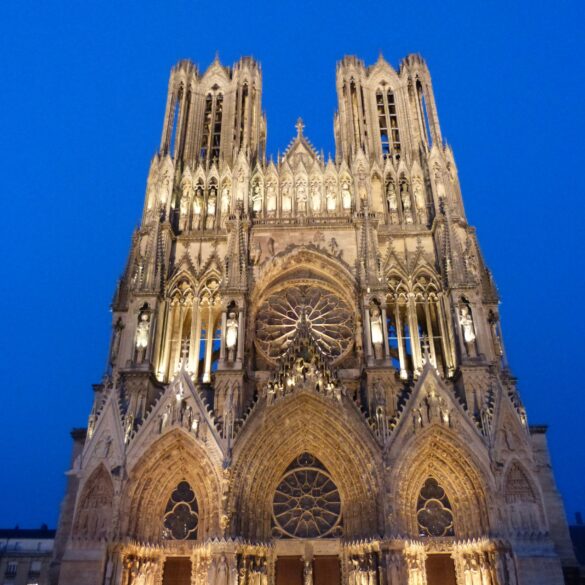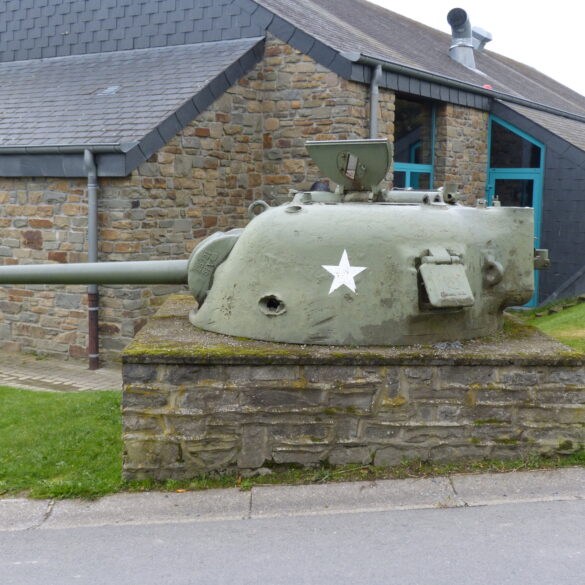Columbus Day weekend was a 4-day weekend for me and we spent it exploring Bastogne, Belgium and the surrounding area.
This was the first photo I took on the trip and I had to include it because I’d never seen anything like this before, but maybe I’m living a sheltered life. This was the elevator control panel in the hotel where we stayed. Fancy, huh?
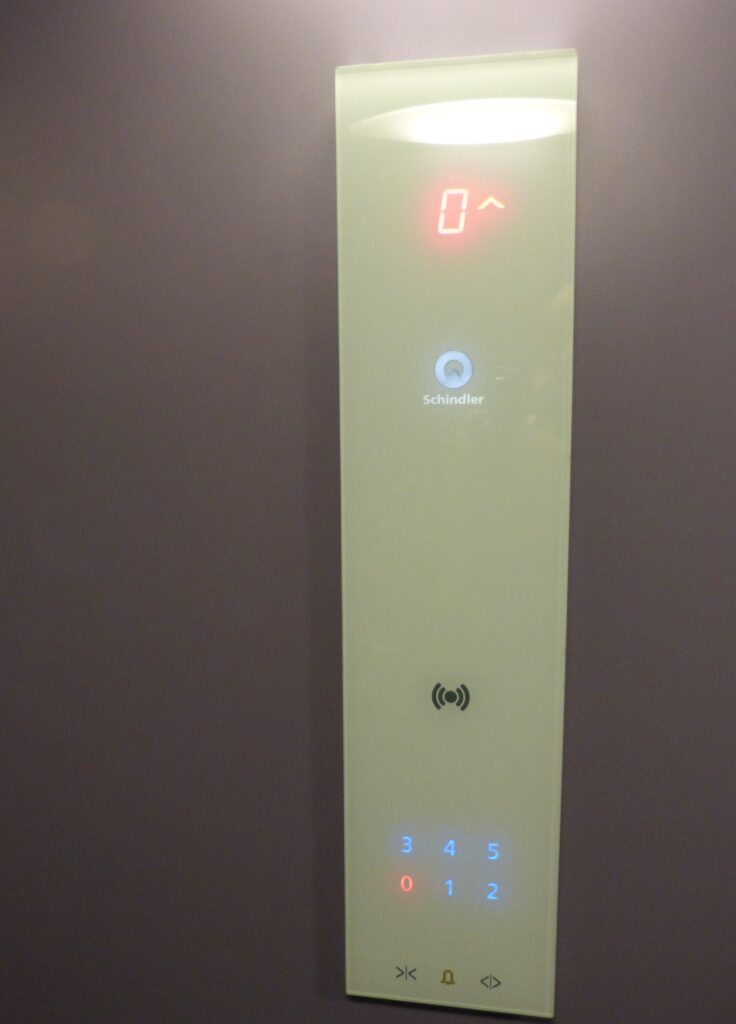
Although we had gone to Bastogne mainly to check out World War II sites, we ended up being amazed by how beautiful the Belgian countryside is. While driving to different towns near Bastogne we ran across lots of farmland, valleys and green, rolling hills.
You would never know that there was so much destruction in the area just under 70 years ago. About 80% of the houses in Bastogne were destroyed during the war, and most of the surrounding villages were almost completely demolished. There were numerous civilian casualties in addition to the military losses.
We arrived in Bastogne at about 1:30 in the afternoon, and after checking into the hotel we headed right out to explore.
On our way to our first destination, we passed by a house with a little mini-farm in the yard. The pygmy goats caught my attention and Sean pulled the car over so I could get a photo. As soon as I got out of the car, every animal in the yard came running over making their various sounds and it was quite noisy. They are obviously used to human admirers and probably were hoping I had food. Anyway, here you can see some pygmy goats, a goose and some chickens and roosters.
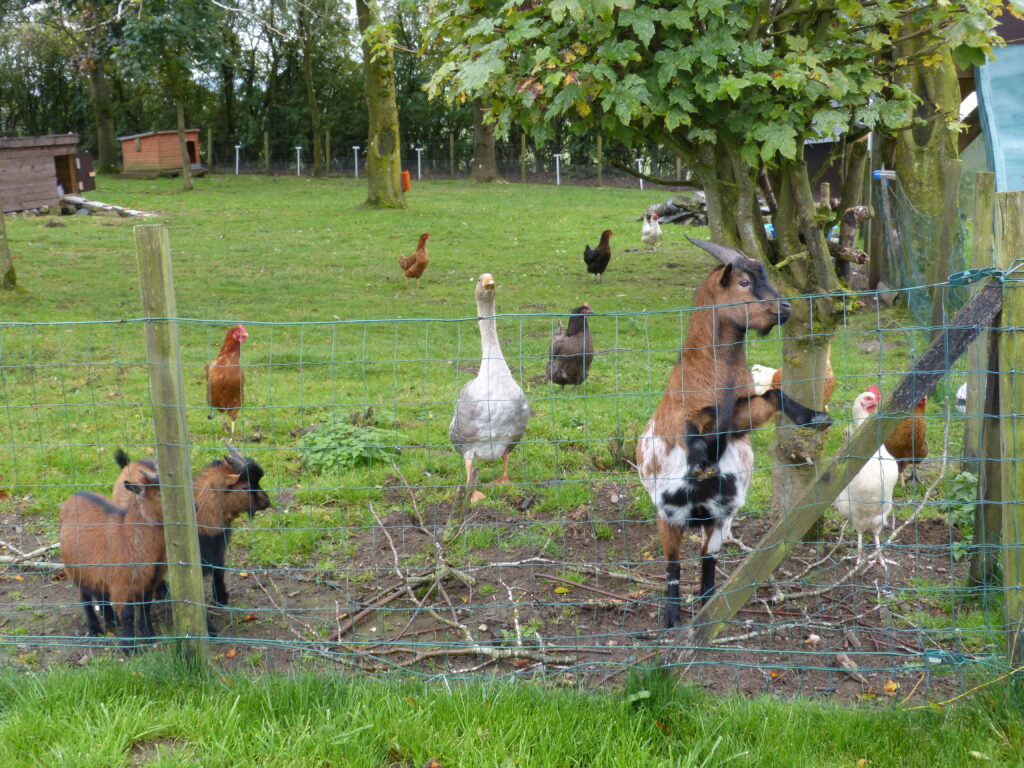
This WW II monument was the first one we stopped at on our first day. If you’ve seen the miniseries Band of Brothers, you will know all about the “E” Company (also known as Easy Company) of the 101st Airborne Division. This monument is dedicated to them and was made possible in part by donations from both the HBO network, who originally aired Band of Brothers, and Tom Hanks, one of the executive producers of the series.
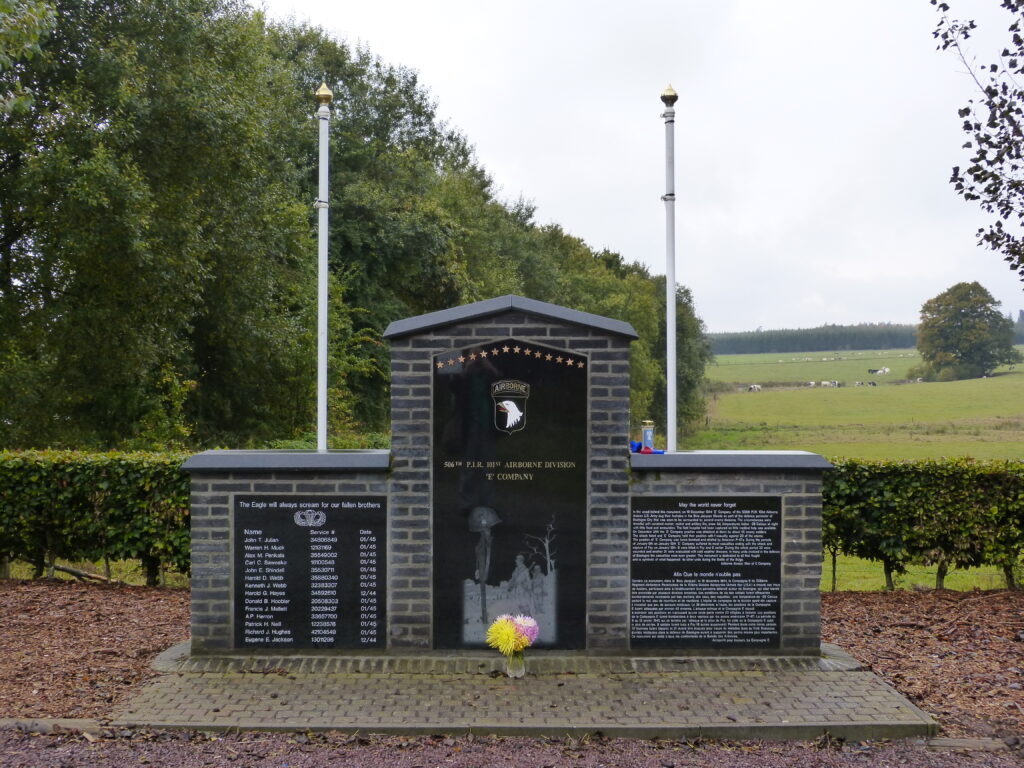
There is a plaque on the monument with the names of 14 Easy Company men who died in the Bastogne area. The plaque has the inscription “The Eagle will always scream for our fallen brothers”. The 101st Airborne Division is also known as “The Screaming Eagles”, so that’s why “Eagle” is capitalized in the inscription.
A little further down the road, Sean parked the car and we went walking into the woods just before the town of Foy. Unbelievably, foxholes from Easy Company are still visible in these woods as you can see in this photo.
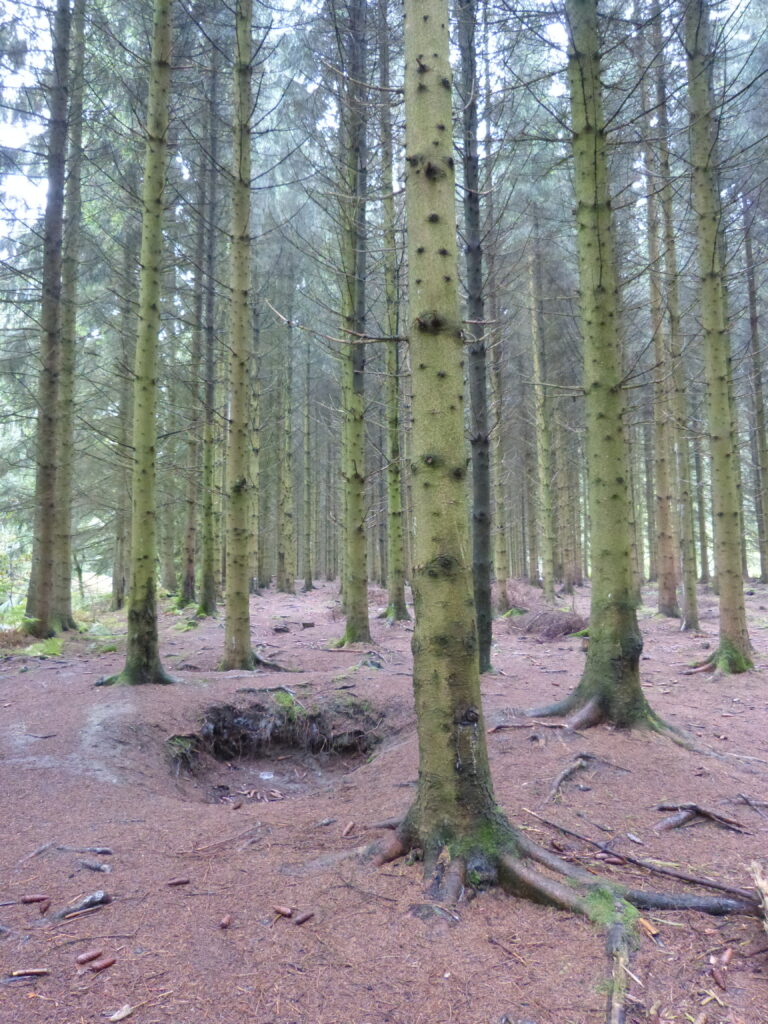
This foxhole had an urn in it and some ashes that had obviously recently been spread. The shapes you’re seeing in the foxhole such as the heart and the cross are actually ashes. Of course we have no way of knowing if these are the ashes of a WW II vet but I thought it was rather touching.
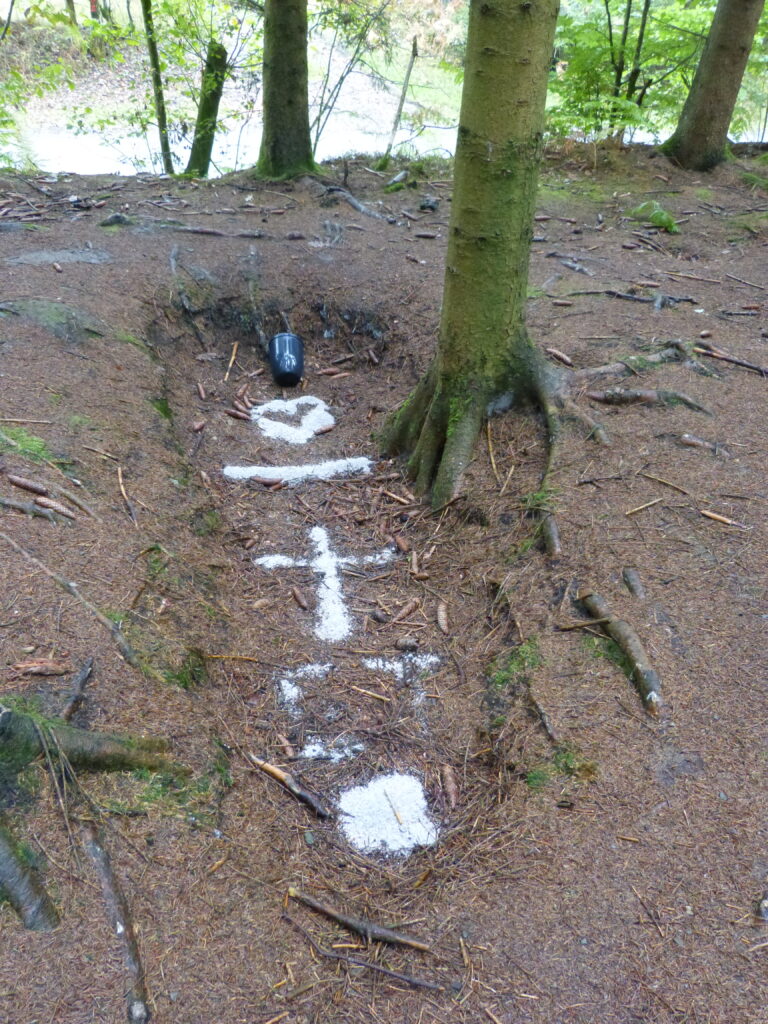
In the same wooded area is this makeshift monument to Easy Company.
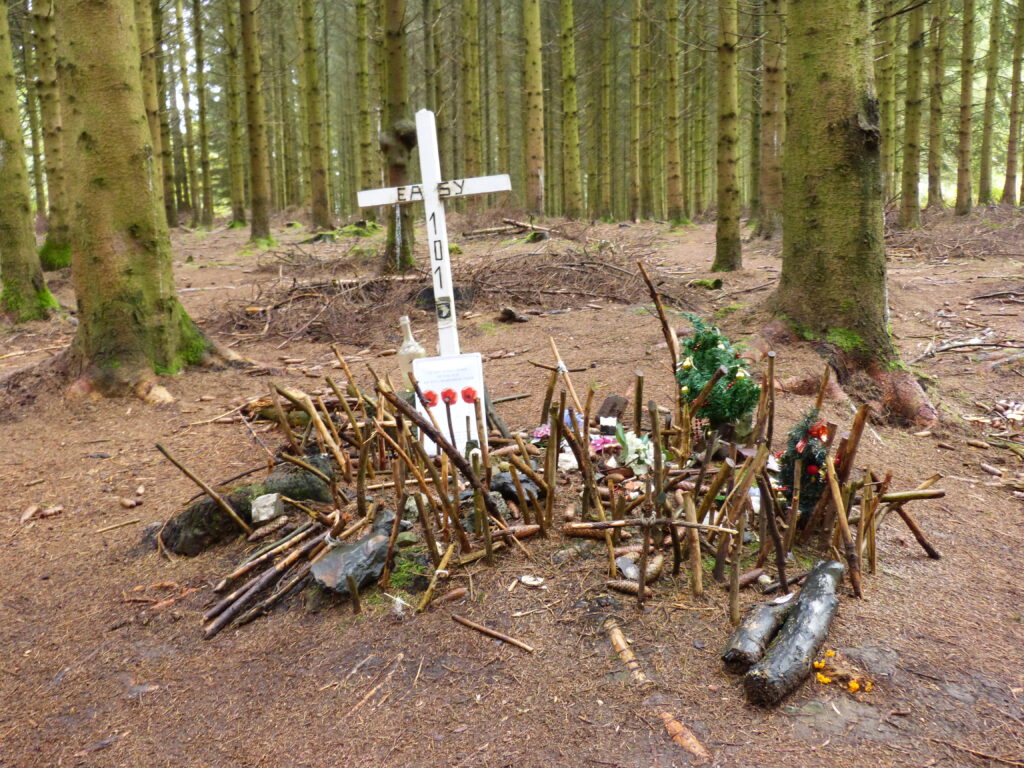
Underneath the cross you see in the photo, the words “At the going down of the sun we will remember them” are written.
Continuing on our drive, we entered the town of Houffalize and saw this pretty scene.
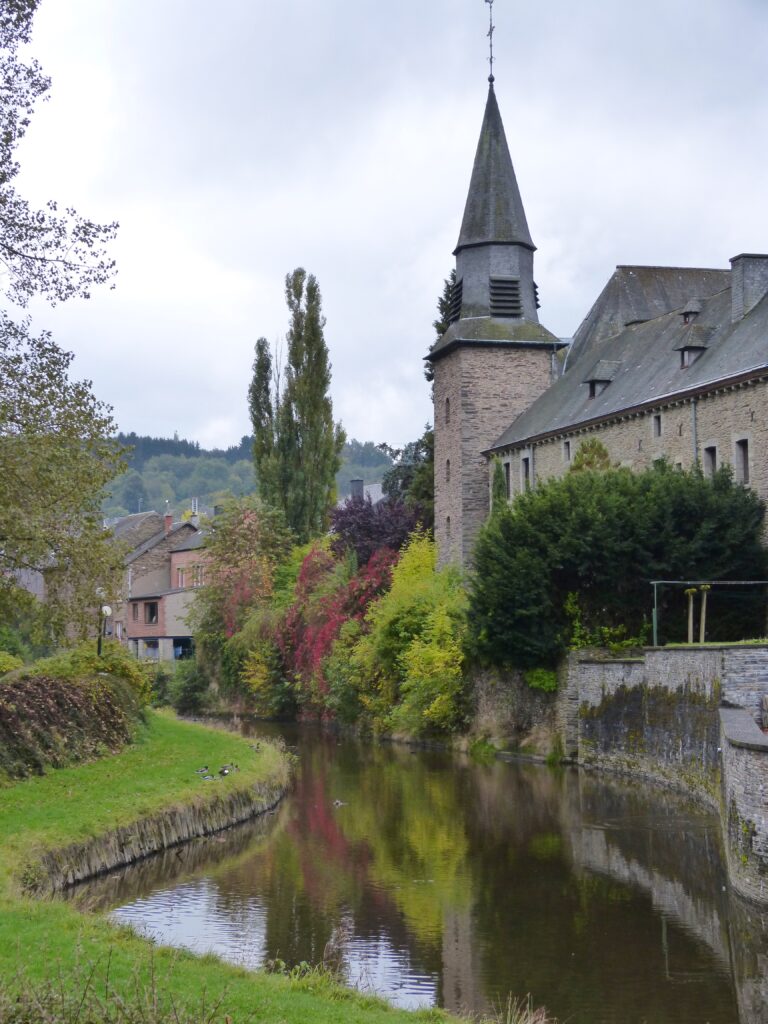
The reason we had gone to Houffalize was because Sean wanted to see this Panzer, which is a German tank.
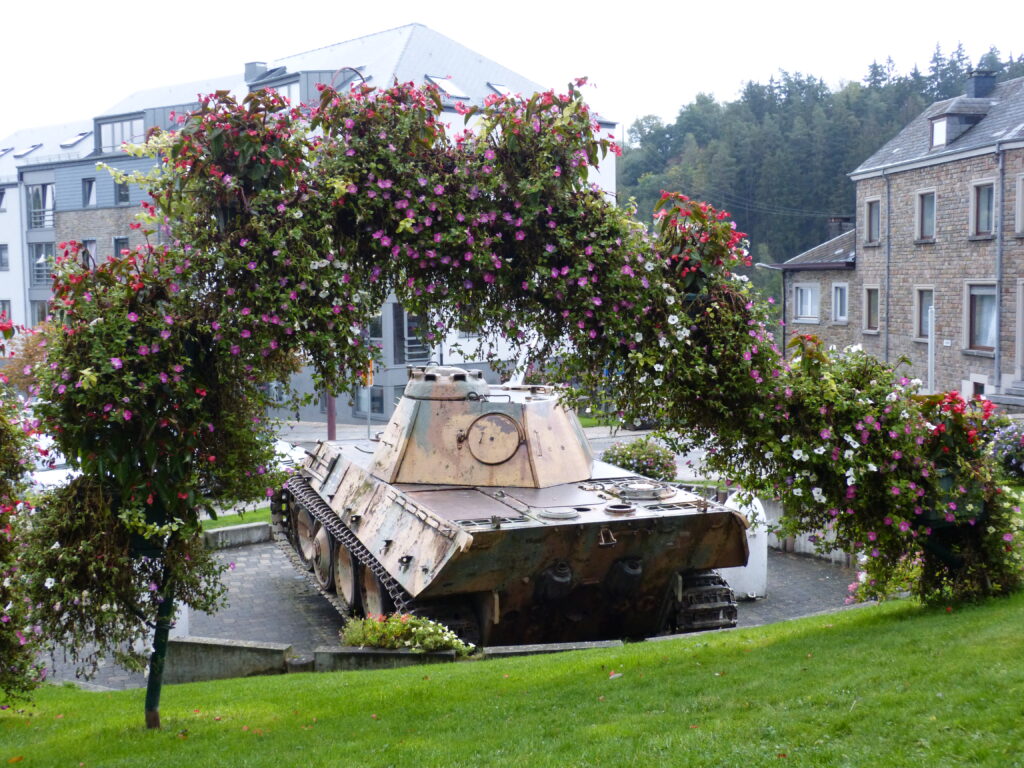
He was very excited because he’d never seen a German tank in person before. I kind of liked the juxtaposition of the tank with these flowers.
I had to post a second photo of the tank because Sean said “Should I take a picture of my big guns with the big gun?” So here he is flexing his muscles even though you can’t see them through the coat.
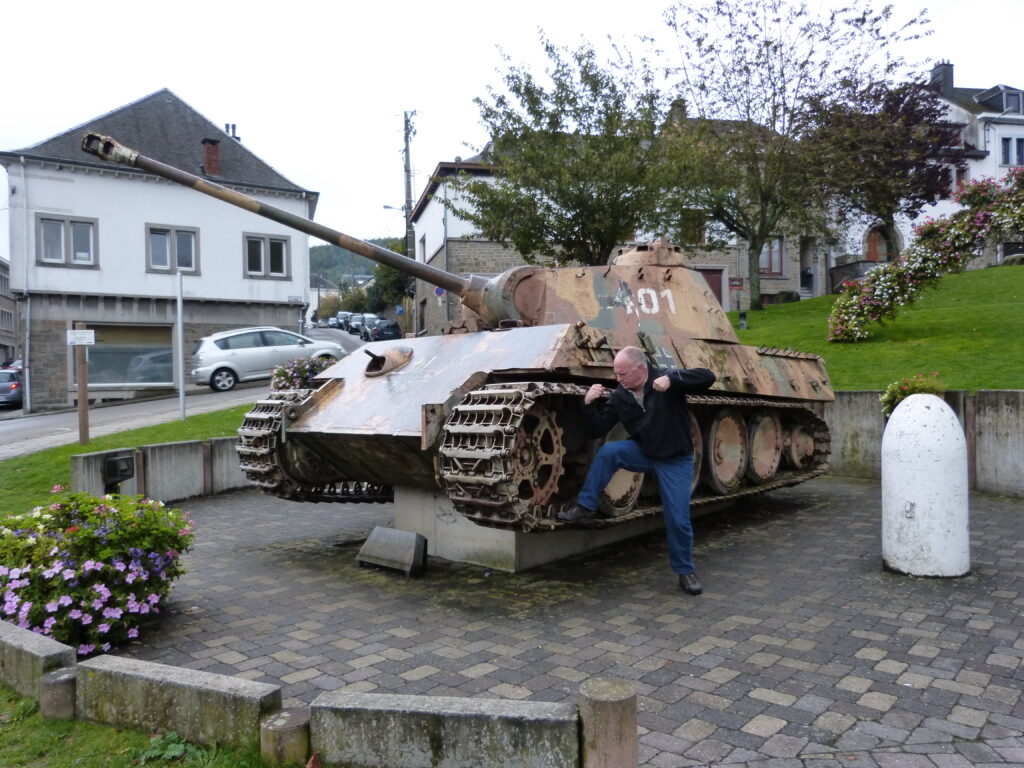
Next on our road trip we arrived at this point.
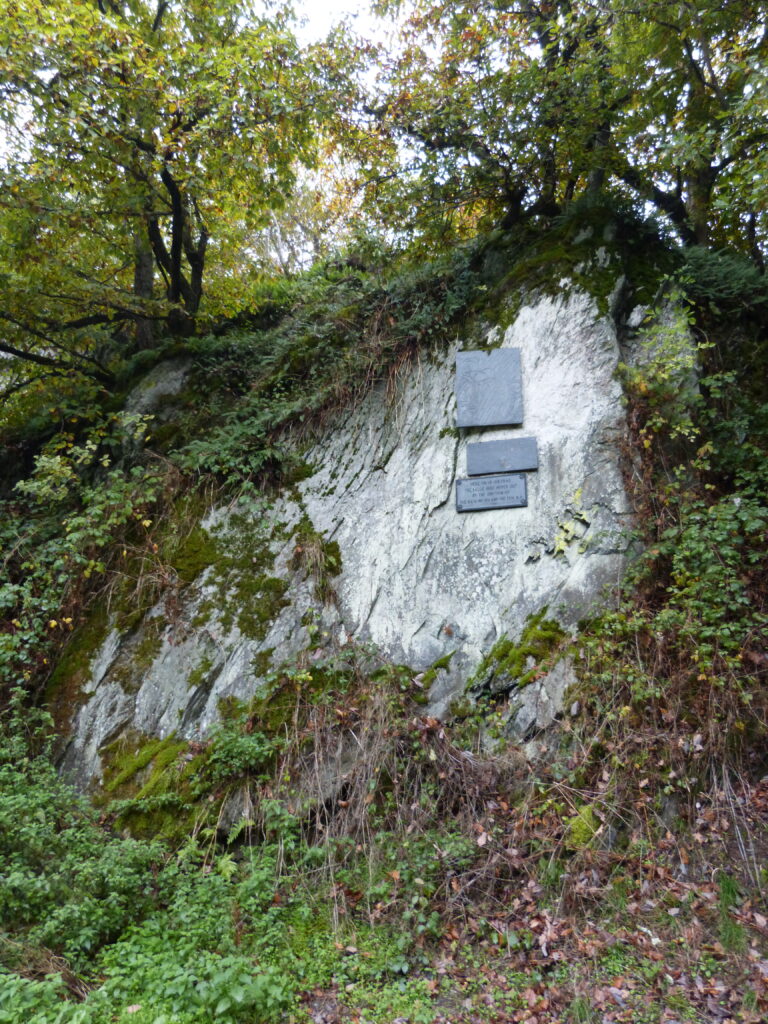
The bottom plaque reads “Here on 16 Jan 1945 The Bulge was wiped out by the junction of the 84th Inf. Div. and the 11th A.D.” The Bulge refers to The Battle of The Bulge, part of which took place in this area.
Those were just a few of the highlights we saw on day one of the trip.
For dinner that evening, we headed towards McAuliffe Square, the main square in town that is surrounded by restaurants. This is one of the restaurants we saw:
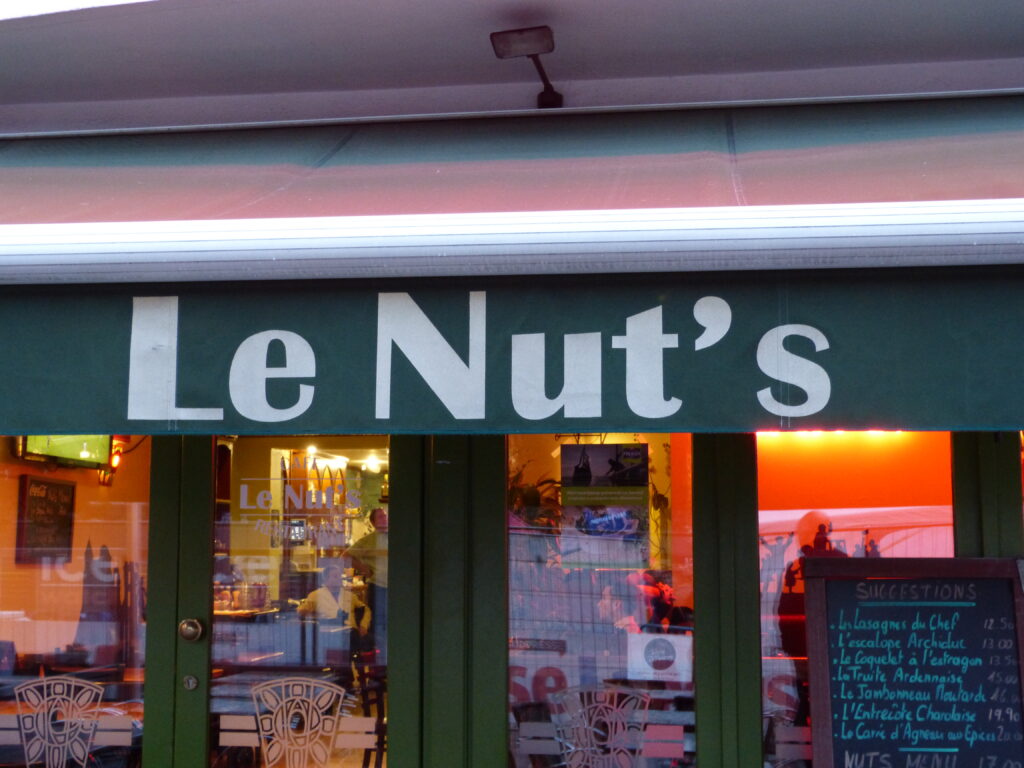
U.S. Brigadier General Anthony McAuliffe was a temporary commander of the 101st Airborne Division during WW II. On December 22, 1944, he received an ultimatum to surrender from General von Lüttwitz, a German commander. The story goes that upon reading the message, McAuliffe crumpled up the paper and said “Aw, nuts”. His aide decided that the official reply to the German General should be sent out as “NUTS”. Hence the name of the restaurant.
As an aside, McAuliffe had arrived in Bastogne after leaving Reims, France. You may have read my blog from visiting there last month. Reims is a big champagne region in France and also happens to be the place where just a few months after the Battle of the Bulge, the Germans surrendered.
At the start of our second day in Bastogne, we ran across this sign for a Bison Farm.
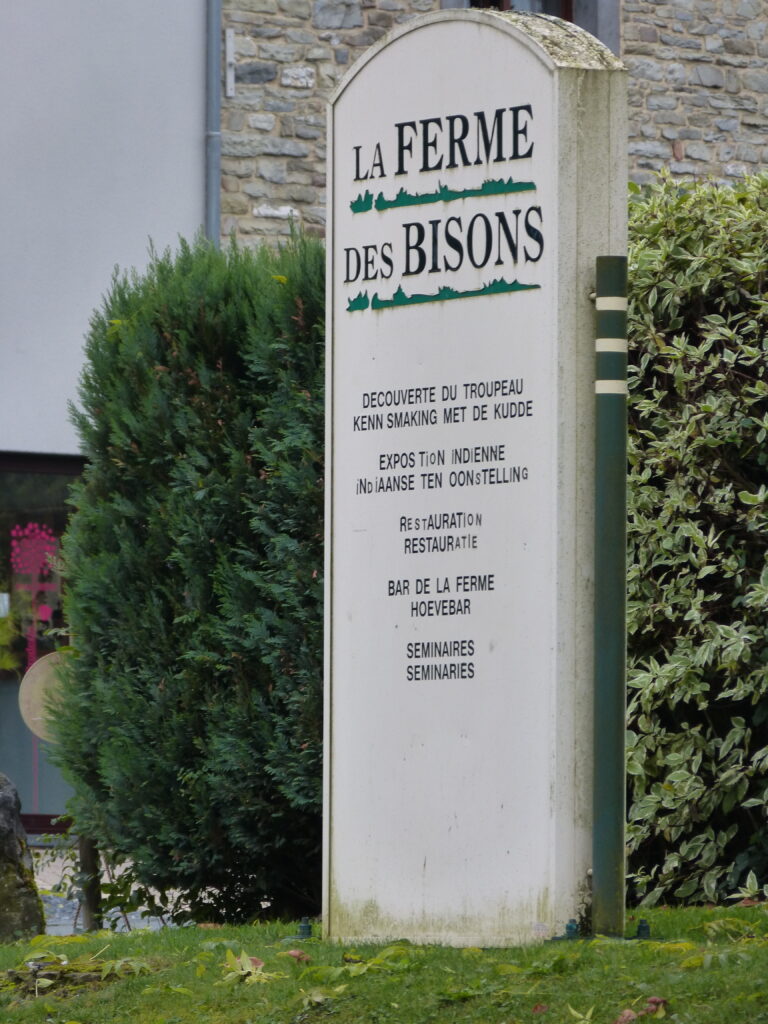
And oddly enough yes, there were actual bison roaming around this farm.
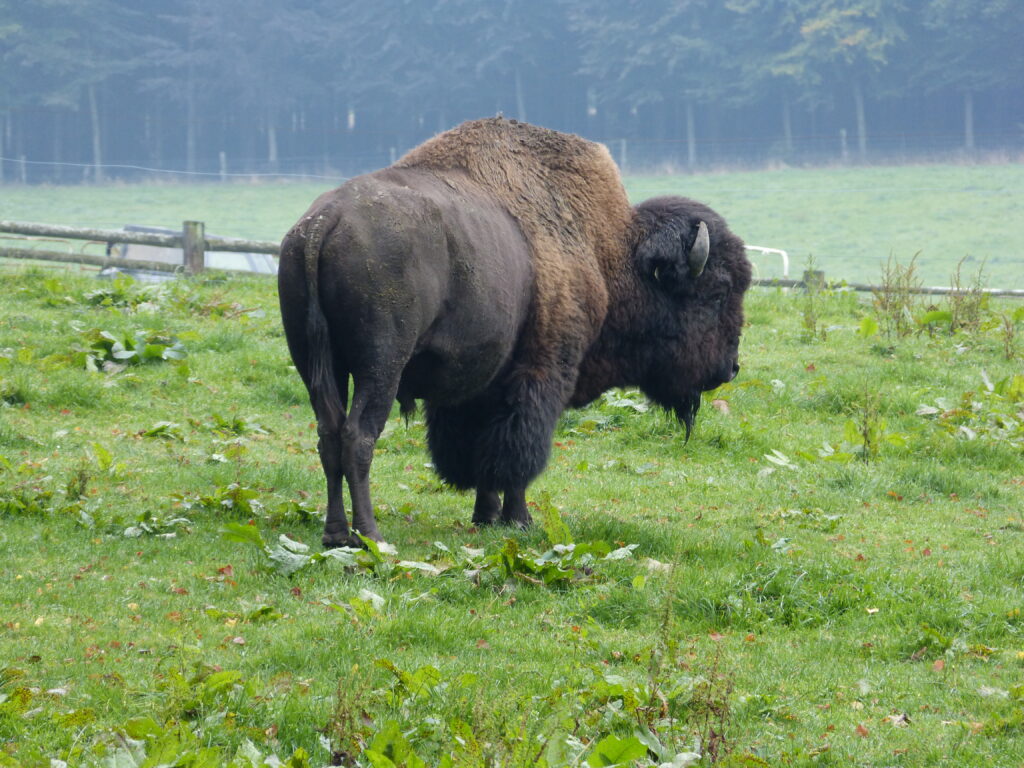
The whole theme at this farm is Native American and it’s just bizarre to see in Belgium. If you’re ever in the area and looking for a place to stay, the Bison Farm has rooms to rent.
After leaving the bison farm, we found this memorial.
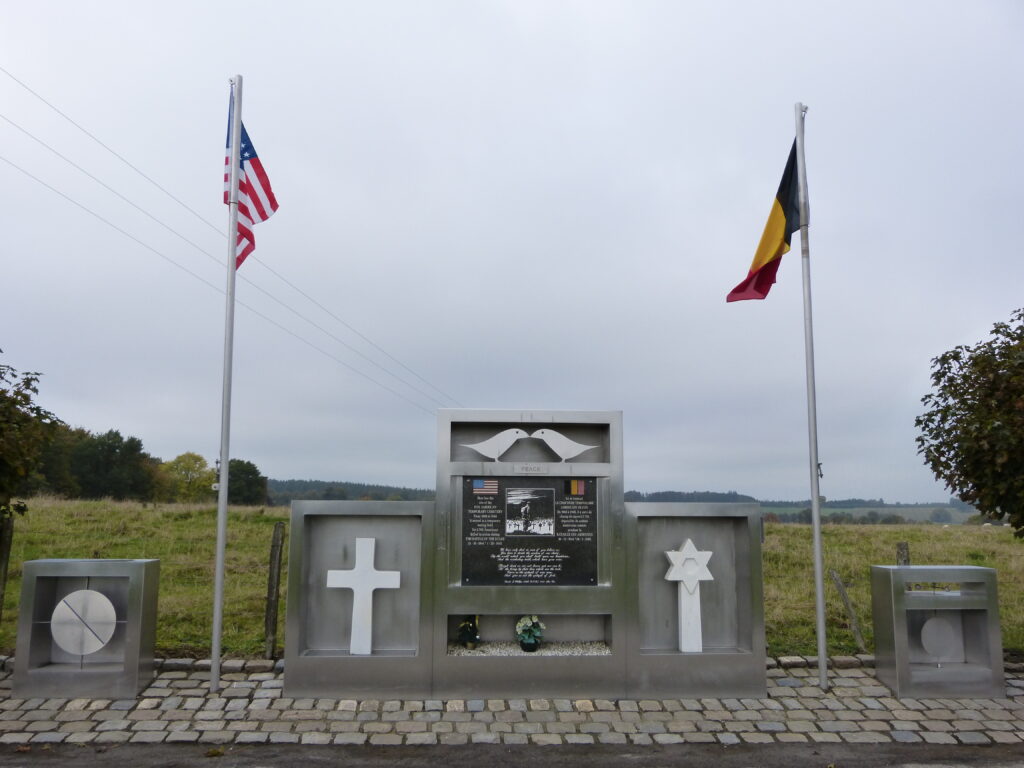
An engraving on the memorial reads “Here lies the site of the Foy American Temporary Cemetery. From 1945 to 1948 it served as a temporary resting field for 2,701 Americans killed in action during The Battle of the Bulge. 12-16-1944 * 1-28-1945” Those originally buried here were either moved back to the U.S. for burial or moved to one of the American military cemeteries in the Ardennes area. (Side note – we normally would have made it a point to visit at least one of these cemeteries, but unfortunately they were closed due to the shutdown of the U.S. government in October 2013.)
The white cross and Star of David markers you see in the memorial are the same kinds that you see in the American cemeteries overseas such as Normandy.
I mentioned that we saw lots of farmland while driving around. I seriously have never seen so many cows in my life.

I guess they need a lot of milk to make all that delicious Belgian chocolate.
This stone had a plaque, written in French (which is the language they speak in this part of Belgium) dedicated to the 3rd Army and the 35th Infantry Division.
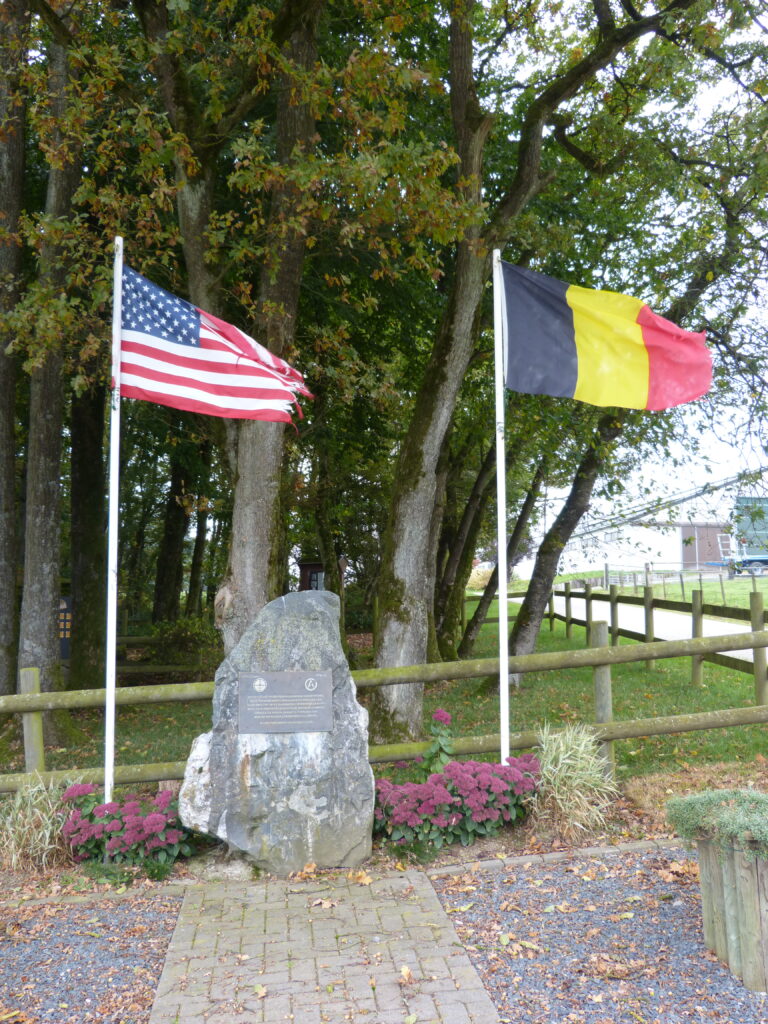
A nice sentiment, but disappointing that the American flag is tattered.
Behind this stone and to the left a bit is this pillbox.
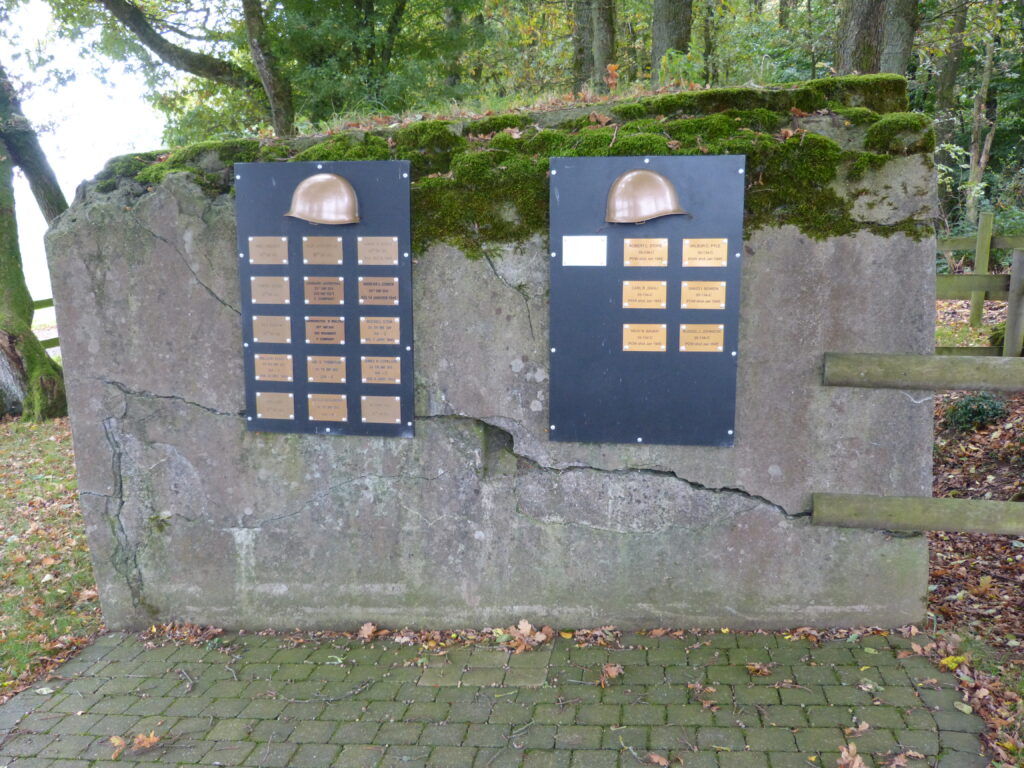
Each one of those little plaques has a name on it. All the names on the right-hand side state that they were POWs (Prisoners of War) who were shot in January 1945.
Out of curiosity, I did a little research on one of the POWs, Wilbur C. Pyle, and found that he
was posthumously awarded the Distinguished Service Cross for heroic action near Pevange,
France. What I found said he was killed in action on January 8, 1945. He was also awarded the
Purple Heart. I couldn’t find anything about him actually being taken prisoner though.
While following some hazy directions to one of the sites on the Historical Route, we got a little lost and ended up in Luxembourg. This isn’t as bad as it sounds as the Belgium/Luxembourg border is very close to Bastogne.
As we were trying to get back on track, we ran across this monument.

One of the plaques on this monument reads “To the honour and in memory of our allied liberators and all those who contributed to restore liberty and justice.”
An informational sign next to the monument states that on December 15, 1944 the 110th Regiment had 150 officers and 2,823 soldiers. This regiment was part of the 28th U.S. Infantry Division (“Keystone”) from Pennsylvania. 8 days later on December 23, 1944 the regiment had only 55 officers and 730 soldiers. My brain just can’t even comprehend the staggering losses that took place during The Battle of the Bulge. Casualty estimates for the American forces for this 5-week battle alone range from 70,000 to over 100,000. This includes killed, wounded and missing service members.
While doing research for this blog, I came across a sad but interesting fact. It seems that the 109th Regiment, which was also part of the 28th U.S. Infantry Division just mentioned, had a dubious distinction. Private Edward Donald Slovik of the 109th Regiment was the only American soldier to be executed for cowardice since the American Civil War. Although 49 death sentences were given for desertion during WW II, Private Slovik’s was the only one carried out, on January 31st, 1945.
One of the reasons we wanted to go to Bastogne was because Sean’s grandfather was there in December 1944 during the Battle of the Bulge.
Sean has a photocopied page of a little diary that his grandfather kept. It covers only 3 days in December.
The first entry is dated December 18, 1944 and reads “Arrived early a.m. at Mande St. Etienne.”
We passed a sign for that town so of course we had to stop and take a photo.
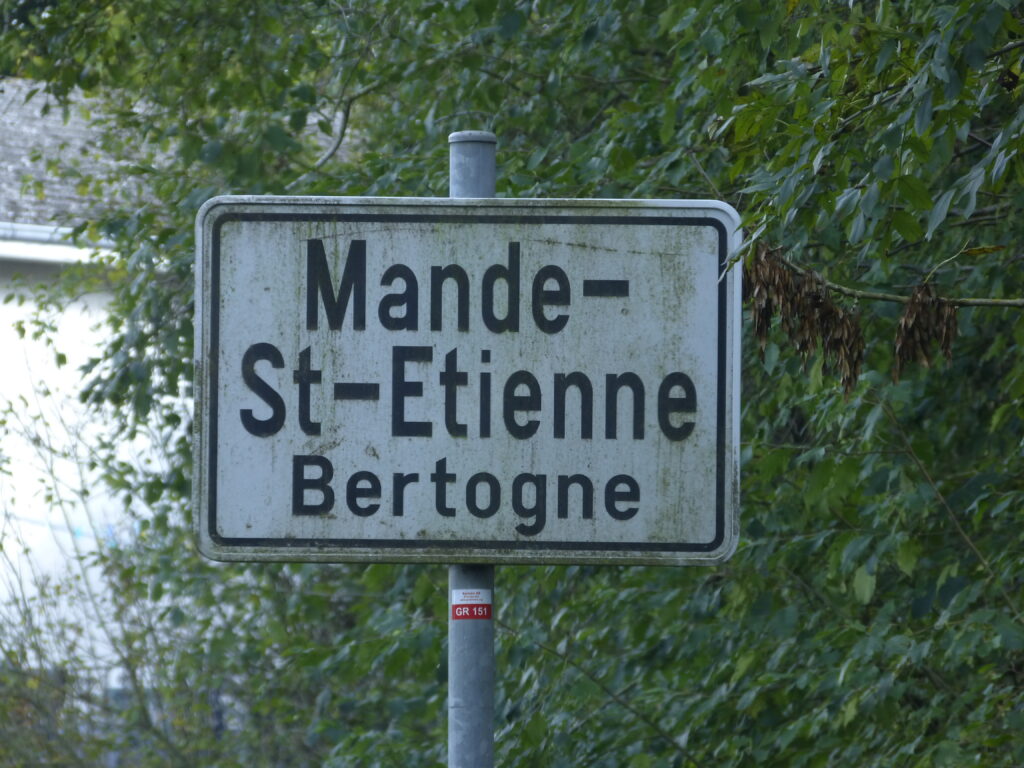
I thought this was a nice little road that we were on, with the trees growing across the road and their leaves meeting to form a canopy.

Here is another monument that we stumbled upon. Anywhere you see an American flag waving in this area, there is going to be some kind of world war monument.
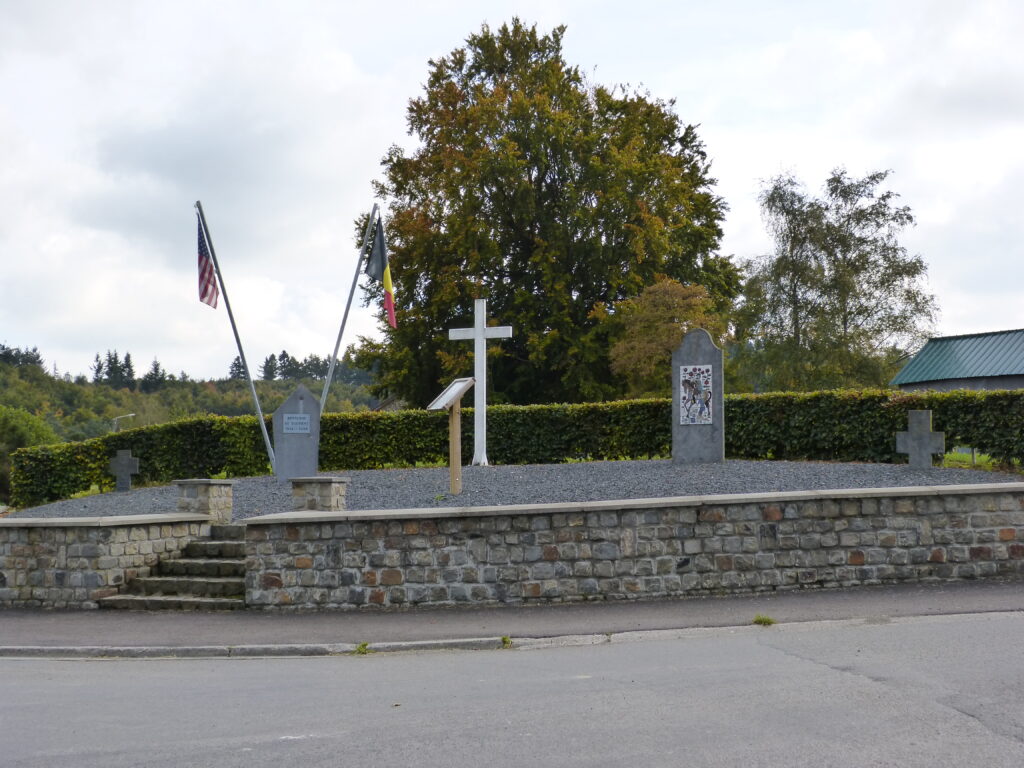
The sign here read “This commemorative plaque was placed here by request of the inhabitants of Champs in memory of the civilian and military victims of the two World Wars.”
Here is another monument that we saw while on our way to the very next town after Champs.
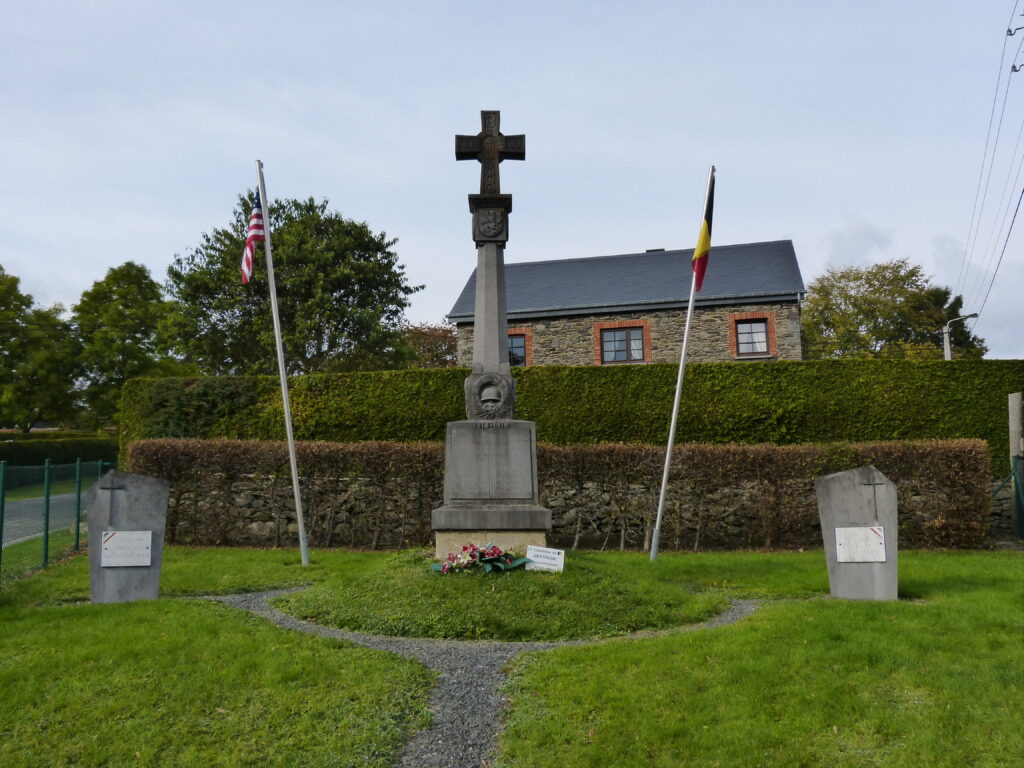
This one had a very similar sign to the one above and it read “This commemorative monument was placed here by request of the inhabitants of Longchamps in memory of the civilian and military victims of the two World Wars.”
Diagnoally across the street from the last place on the Historical Route is this Sherman tank turret. Just behind that little white fence you see to the right of the turret is a private home. I’m not sure I’d want one of these right outside my front gate, although it sure does make a statement. This tank marks the defensive perimeter of Bastogne during the war.
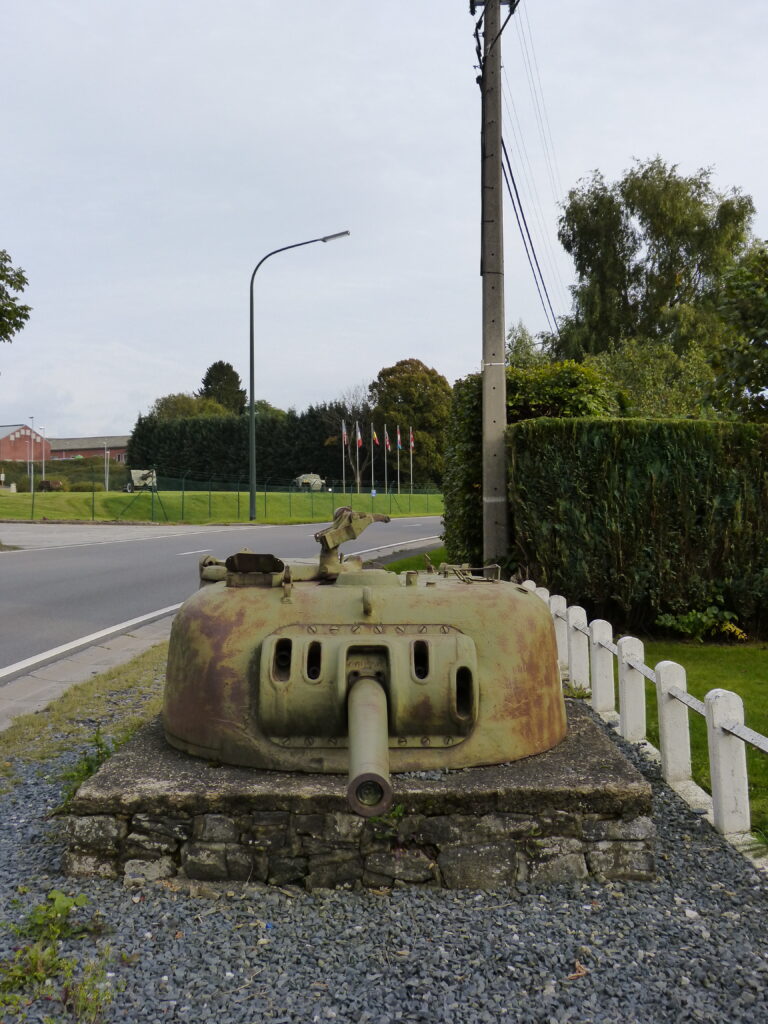
After finishing the Historical Route we decided to take in one more sight for the day and headed over to the Mardasson Memorial. This is at the entry to the monument and the plaque reads “May this eagle always symbolize the sacrifices and heroism of the 101st Airborne Division and all its attached units. December 1944 – January 1945. The City and Citizens of Bastogne.”
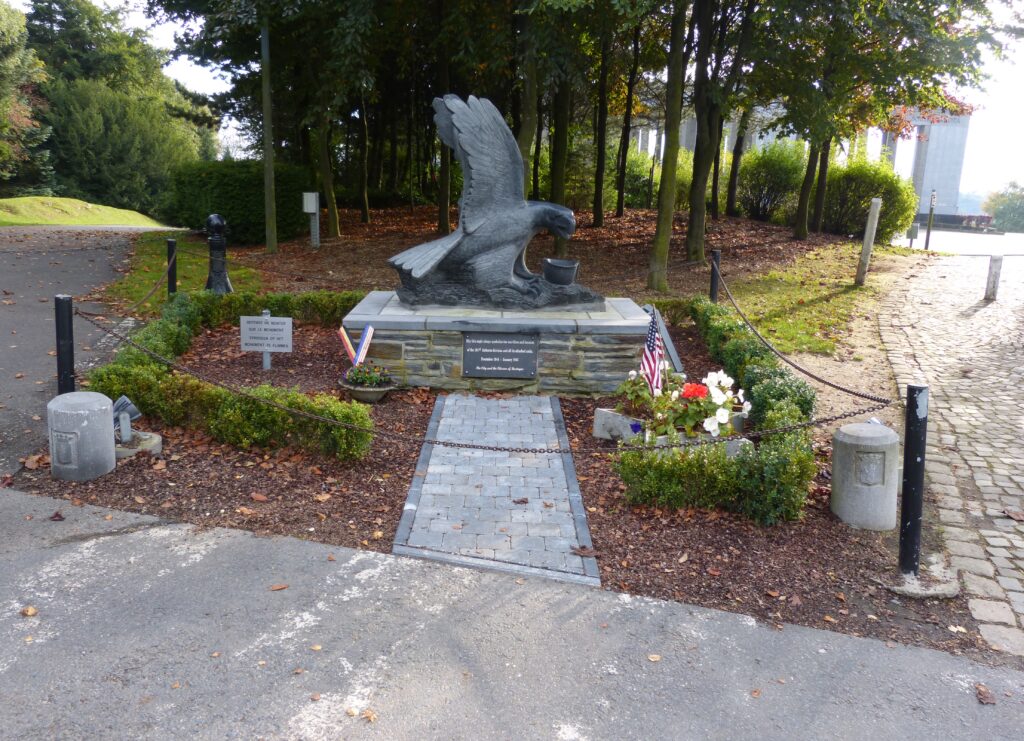
Here is a photo of the memorial, which was dedicated on July 16, 1950. The memorial honors American soldiers who were killed or wounded during the Battle of the Bulge and as you read above, this is at least 70,000 soldiers. The memorial is built in the shape of a five-pointed star.
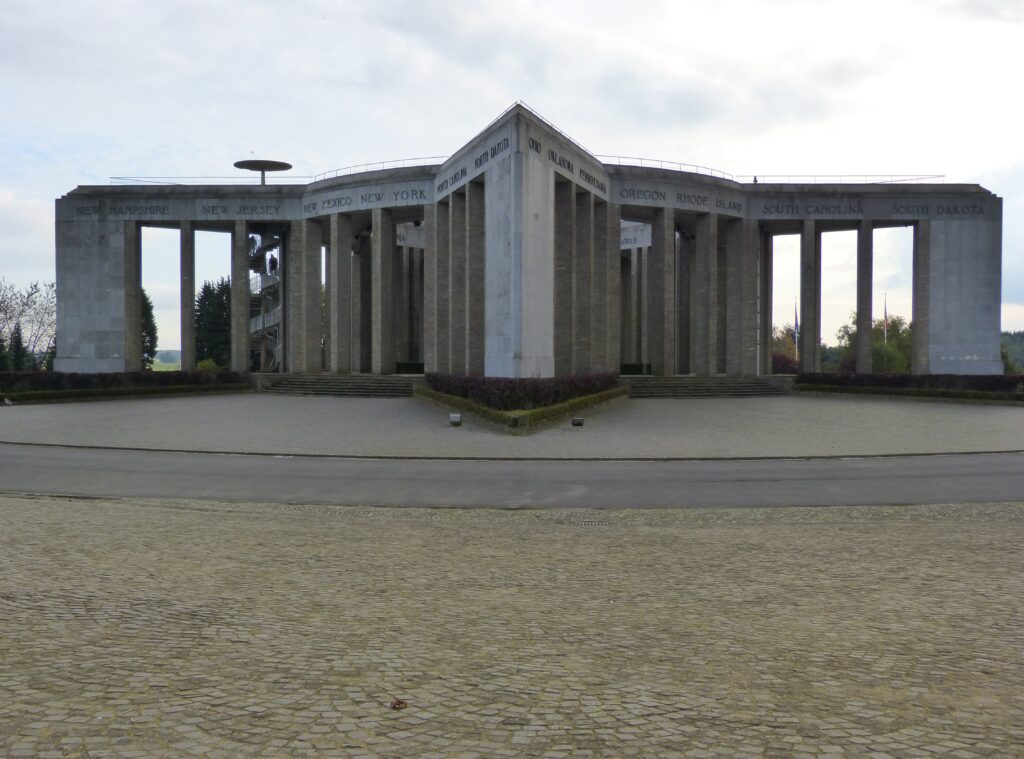
If you look to the left in the photo you will see a metal circular thing on top of the memorial. This is the top of a spiral staircase, which you can also see. We climbed up the staircase and saw what are now beautiful views but were once battlefields. You may also be able to make out the names of U.S. states engraved at the top of the memorial.
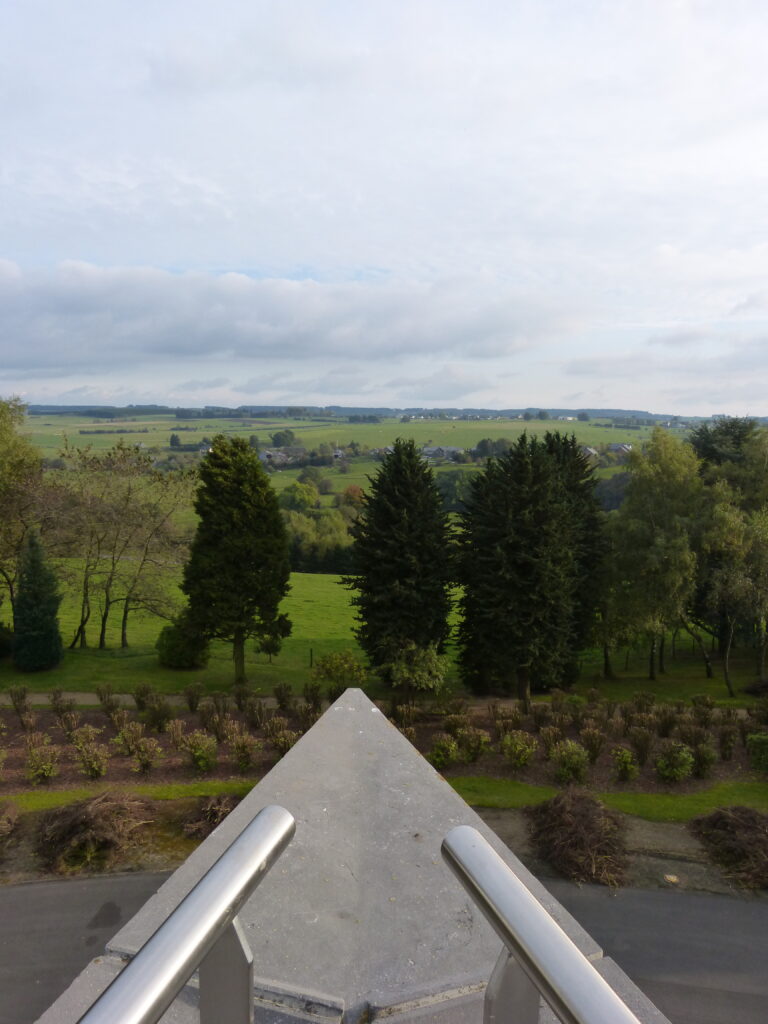
In the middle of the memorial is this stone with the inscription:
LIBERATORIBVS
AMERICANIS
POPVLVS BELGICVS
MEMOR
IV.VII.MCMXLVI
It means “The Belgian people remember their American liberators. 04.07.1946” (That last part is the date July 4th, 1946.)
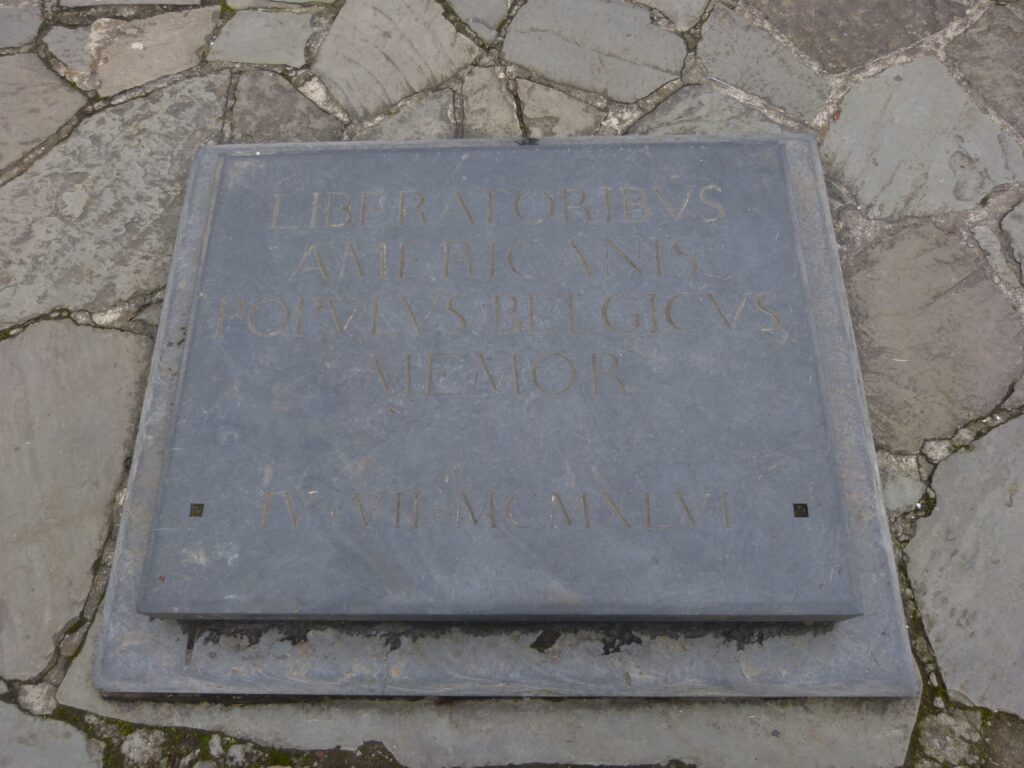
Down these steps is a crypt, which was not open at the time we were there.
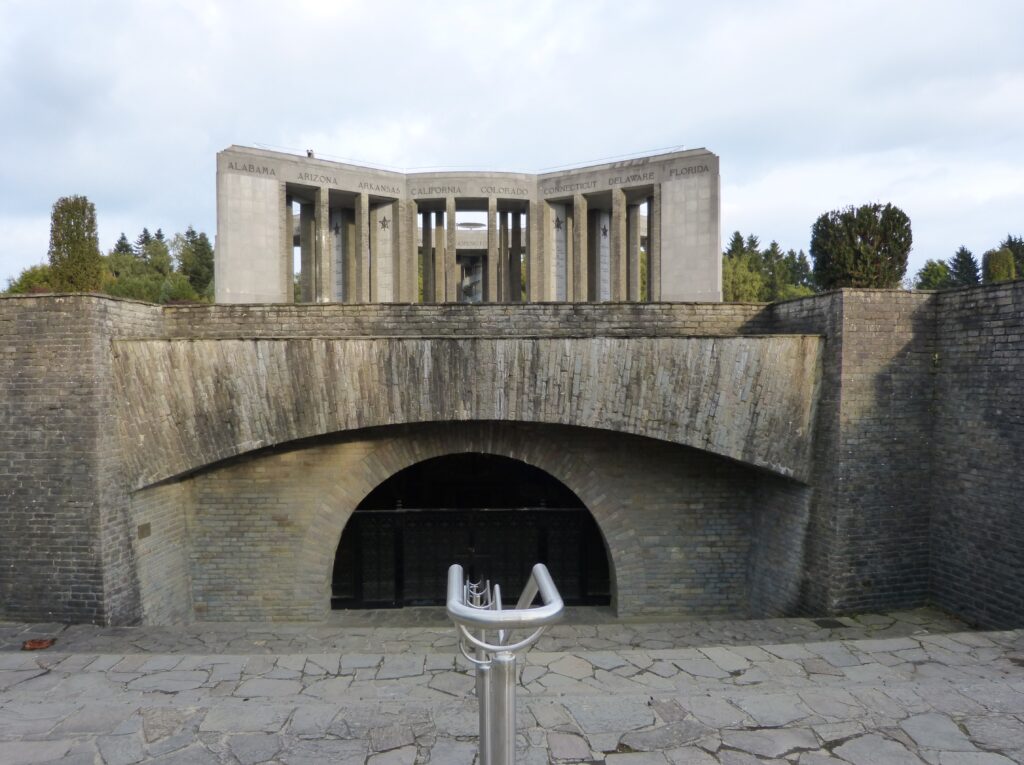
Inside the crypt are three different altars for Catholic, Jewish and Protestant services.
This kilometer marker is just down the road from the memorial. It is the last marker on the Liberty Road, which starts in Sainte-Mère-Église in France and ends in Bastogne. As you can see, this marks the final kilometer, number 1,147. A little booklet we had gotten with information about various driving tours says that “Each stone bears a flaming torch rising from the ocean, a replica of the one held by the Statue of Liberty at the entry of the port of New York.”
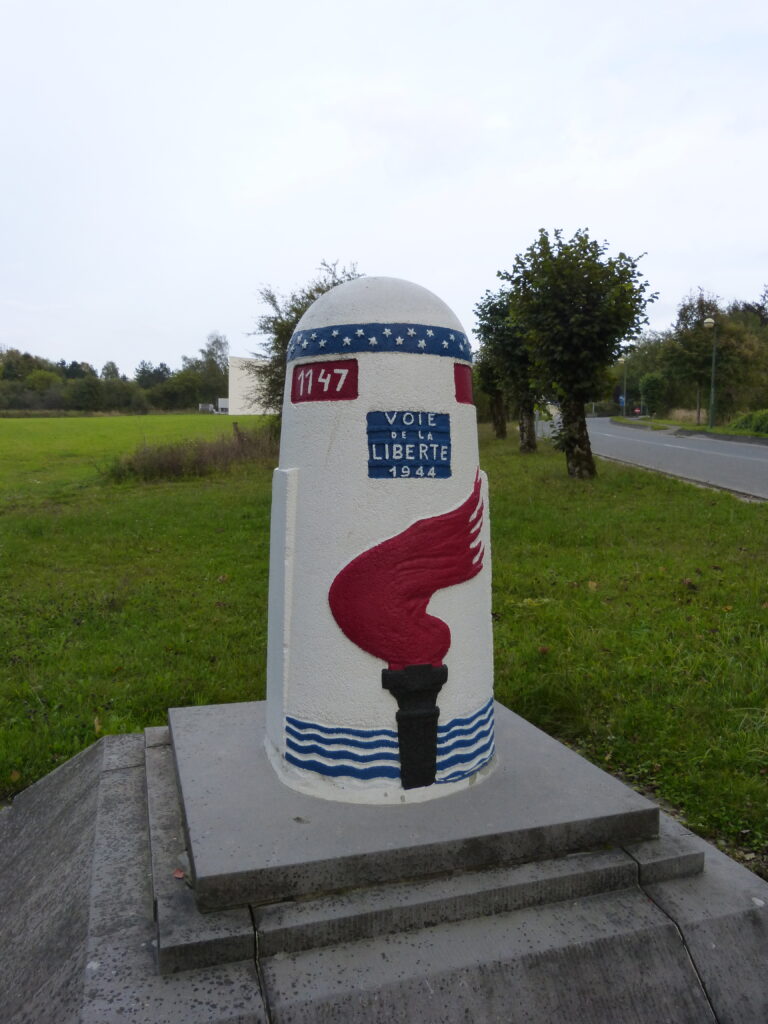
You can read more about the Liberty Road here http://en.wikipedia.org/wiki/Liberty_Road_(France)
That was the end of our tour for the second day. That evening, we went back to McAuliffe Square to eat dinner at one of the many restaurants there and saw this. Mon Dieu! Call the police, someone has parked terribly!
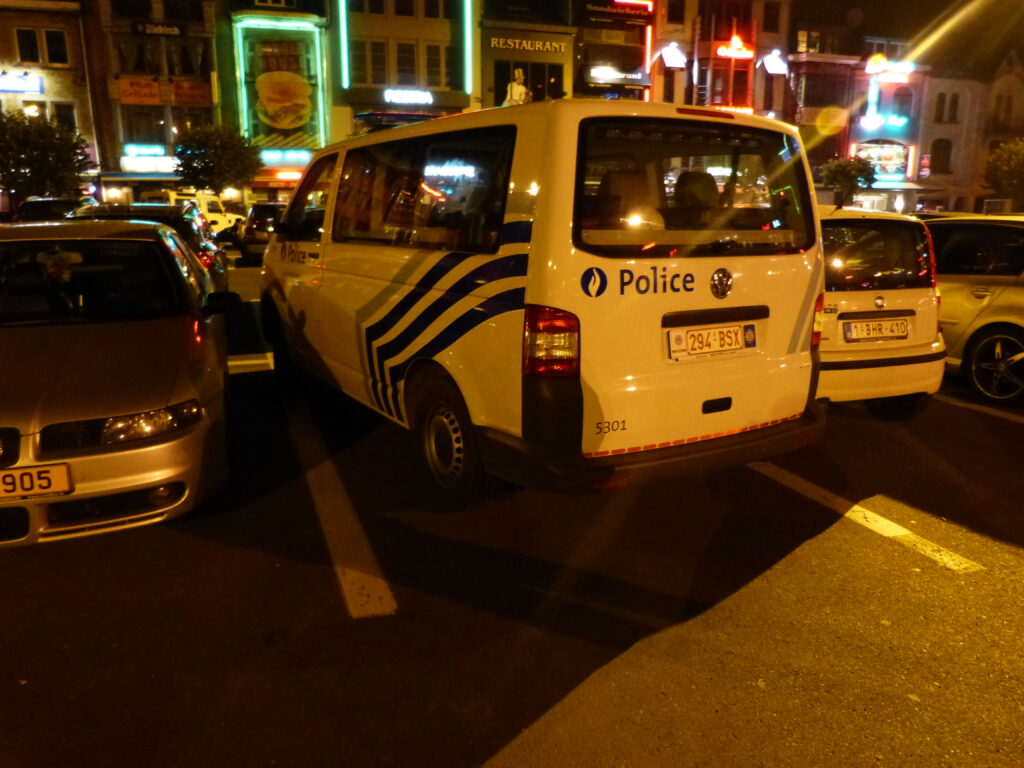
On Day 3, we headed to the town of La Roche-en-Ardenne. One of the first things we saw was this rack holding bottles of beer and pointing to a store with over 350 kinds of beer. God bless Belgium.
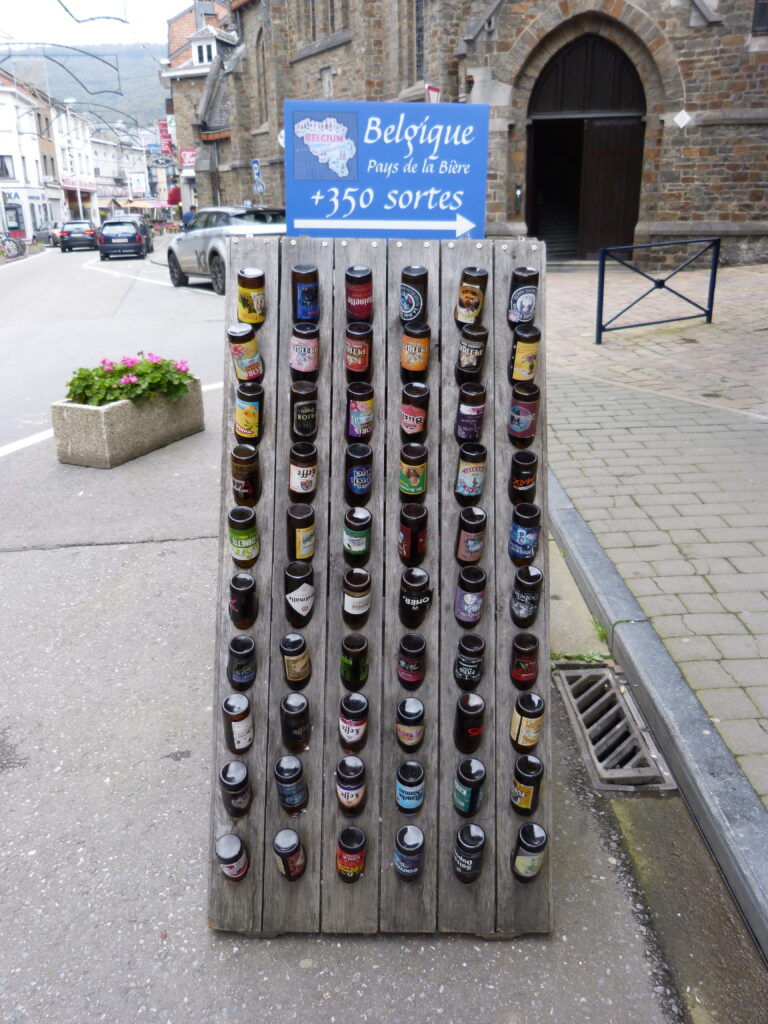
Of course there are several WW II points of interest in this town too.
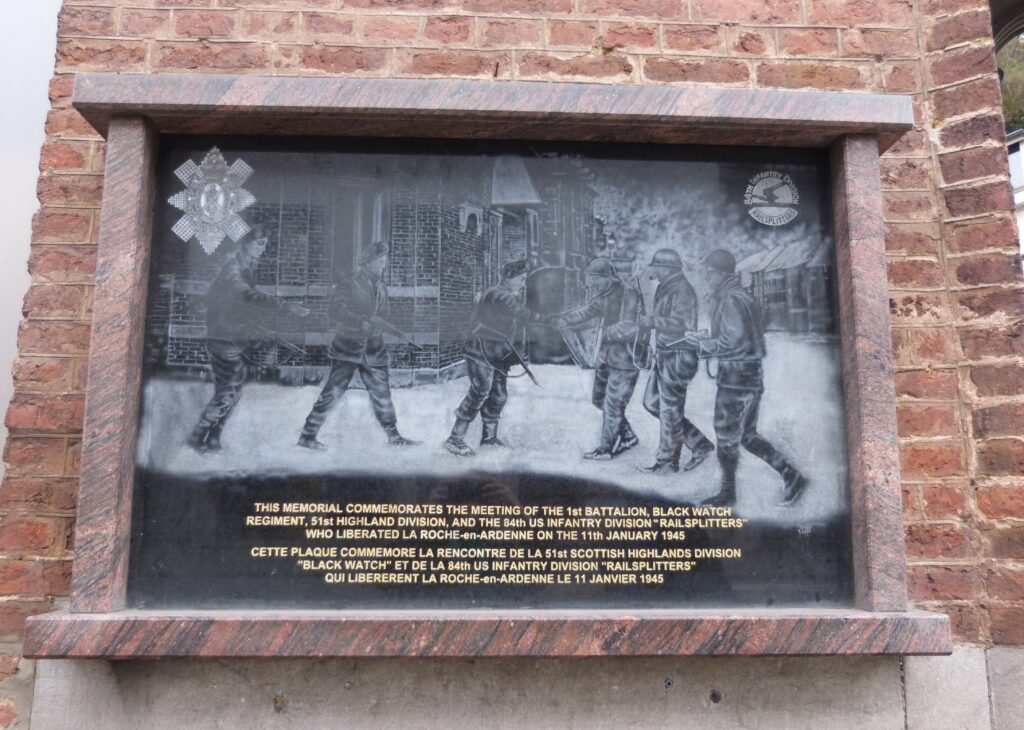
This plaque on the side of a building reads “This memorial commemorates the meeting of the 1st Battalion, Black Watch Regiment, 51st Highland Division, and the 84th US Infantry Division “Railsplitters” who liberated La Roche-en-Ardenne on the 11th January 1945.
That first battalion mentioned is Scottish.
While we were in town, we visited the Battle of the Ardennes museum. One of the more interesting (to me, at least) things in the museum was this Enigma machine.
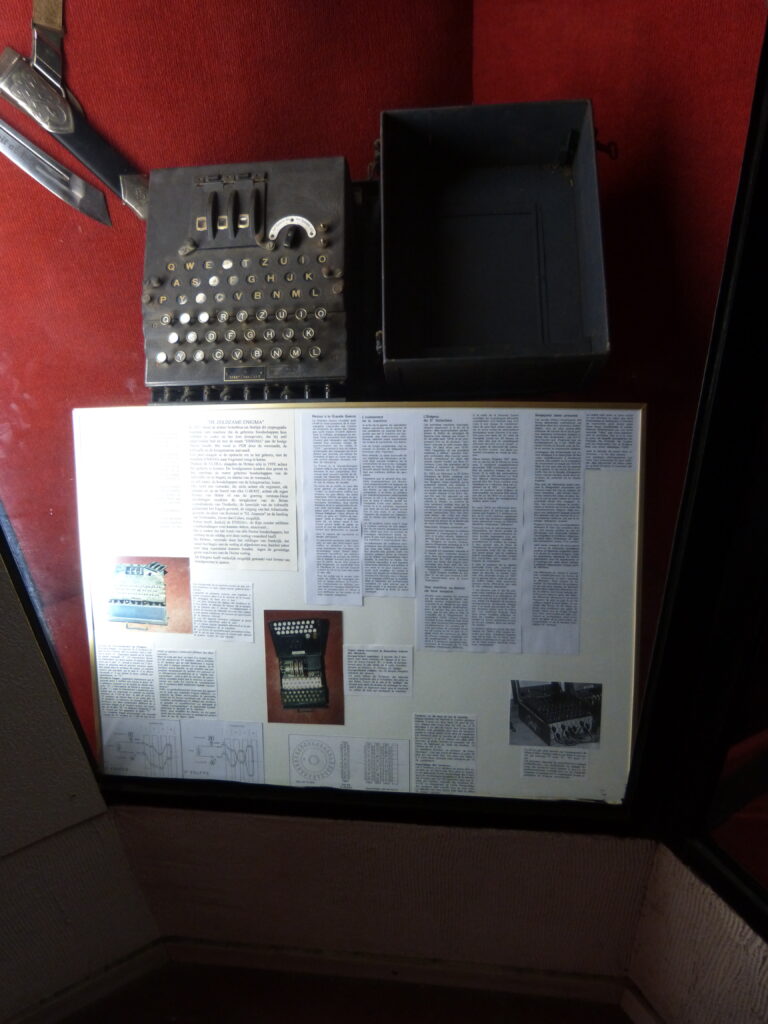
These machines were used to encrypt and decipher secret messages. When I was a kid, “Harriet the Spy” was one of my favorite books (and still is) so I guess I still have a bit of that longing to be a spy in me.
After the museum we visited the Château de La Roche-en-Ardenne, which is a ruined medieval castle. We had some nice views of the town from the top of the ruins as seen here:
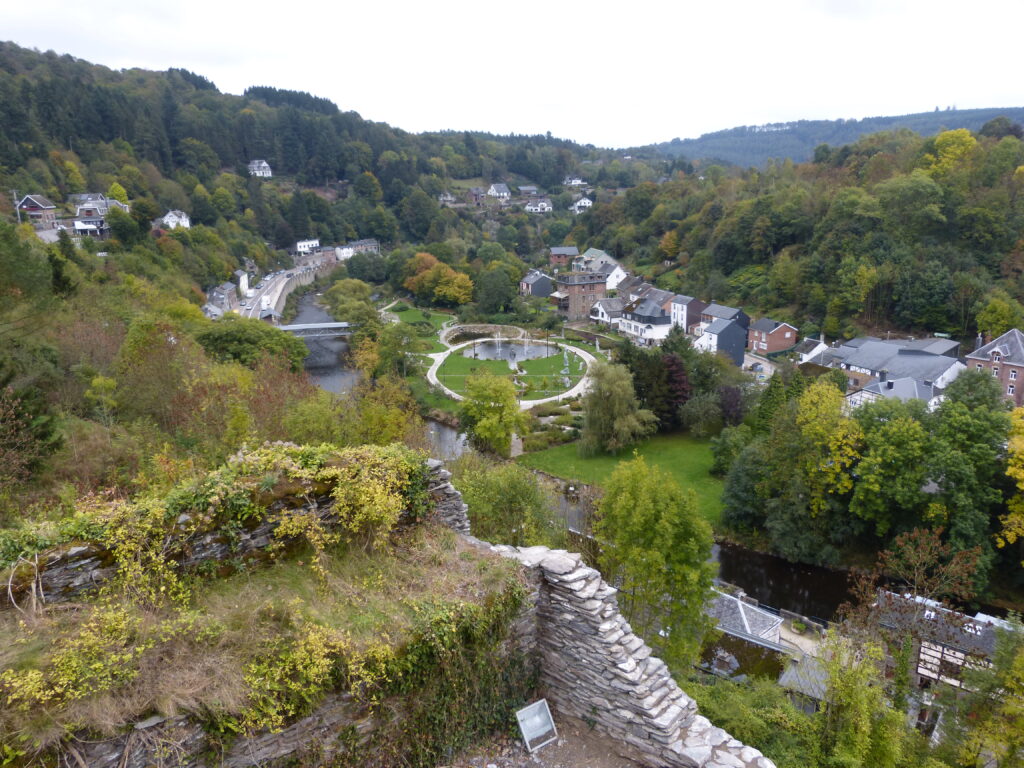
And here:
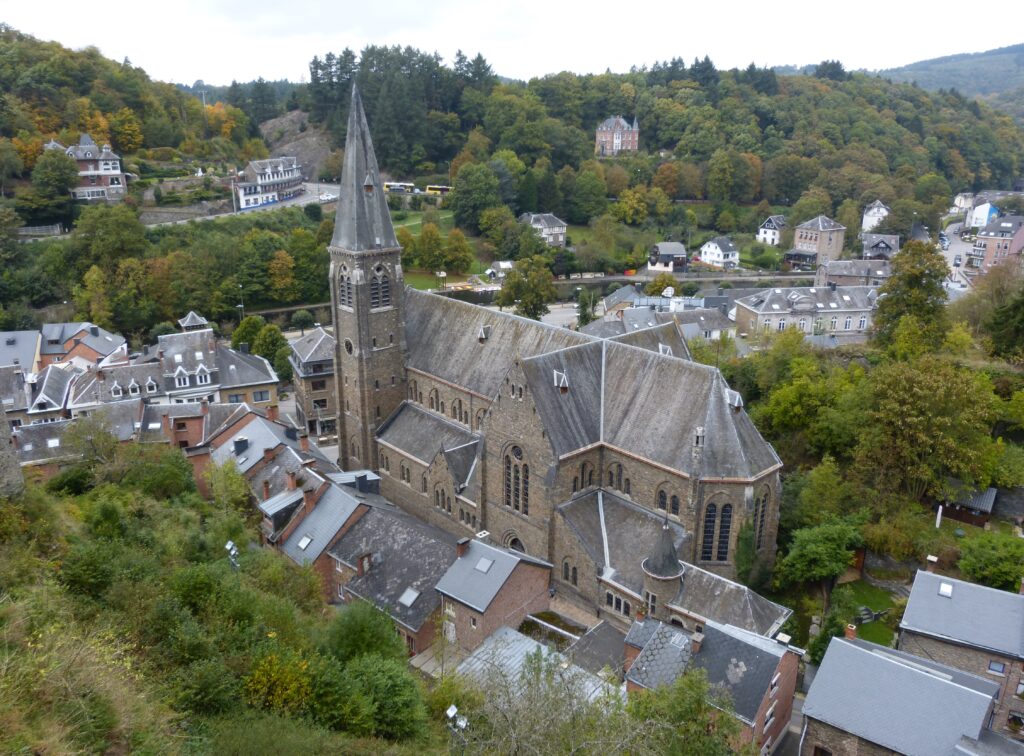
These were, I have to say, probably the best castle ruins I have ever seen, and we’ve been to quite a few. If you pay an additional 50 cents to your entry fee you get a map of the ruins and the woman working at the entry gate was kind enough to give us two maps for the price of one. Thanks to the map you knew exactly which part of the castle you were in at any given time, plus there were helpful signs posted around the castle to correspond with the map and let you know where you were. Usually you just go to these ruins and say “Huh” and the views below are better than the actual ruins because you have no idea what you’re seeing in the castle. In this case I really enjoyed walking around the ruins thanks to the information we had. I actually wish we would have had more time there but we had to get back to the car because the metered parking was about to run out and we really didn’t feel like dealing with having our car towed in Belgium.
Before moving on, I also want to point out that there is a supposedly a ghost at this castle. A sign we saw later said “Every day during July and August (on Saturdays from Easter to September) Bertha de la Roche’s ghost appears at the peak of the ruins.” I’m pretty impressed by a ghost that can keep a schedule like that.
After leaving the castle we went to see this British tank destroyer. Our driving tour brochure says this “…was the first tank to enter the town behind the 1st Black Watch.” You may remember reading about the 1st Black Watch a few photos back. A plaque on the tank reads “Achilles tank destroyer MK10. Honour and tribute to the 1st Northamptonshire Yeomanry who supported the 51st Highland Division in the liberation of La Roche on 11th January 1945.”
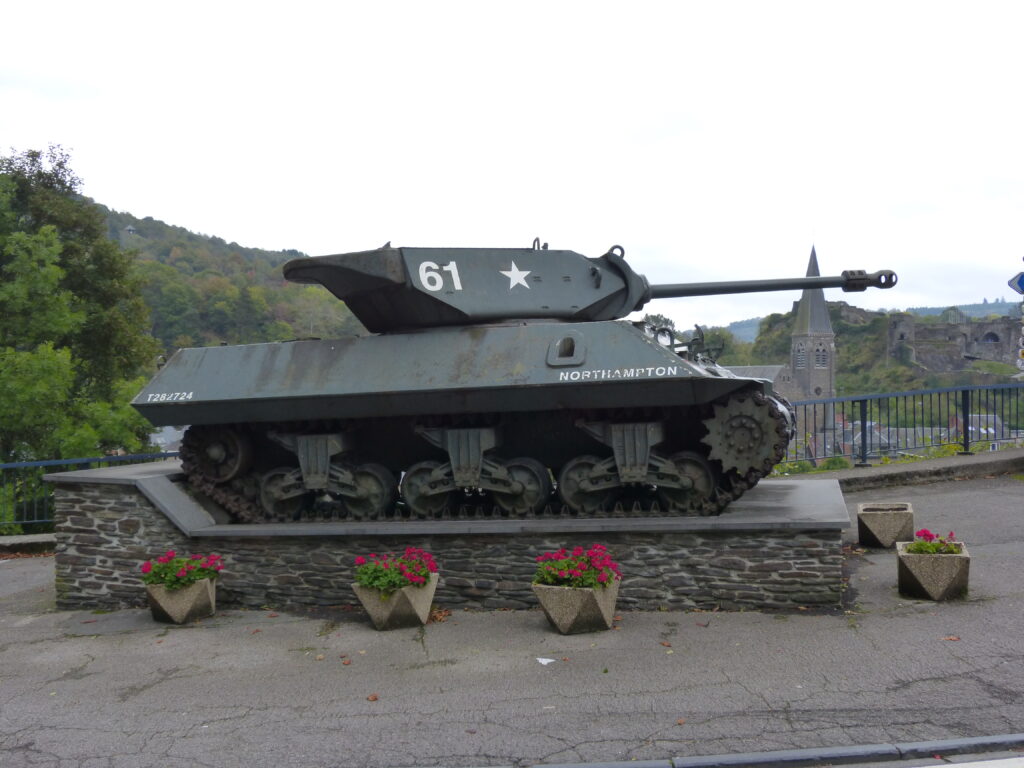
Our next stop was the town of Hotton to visit a British war cemetery.
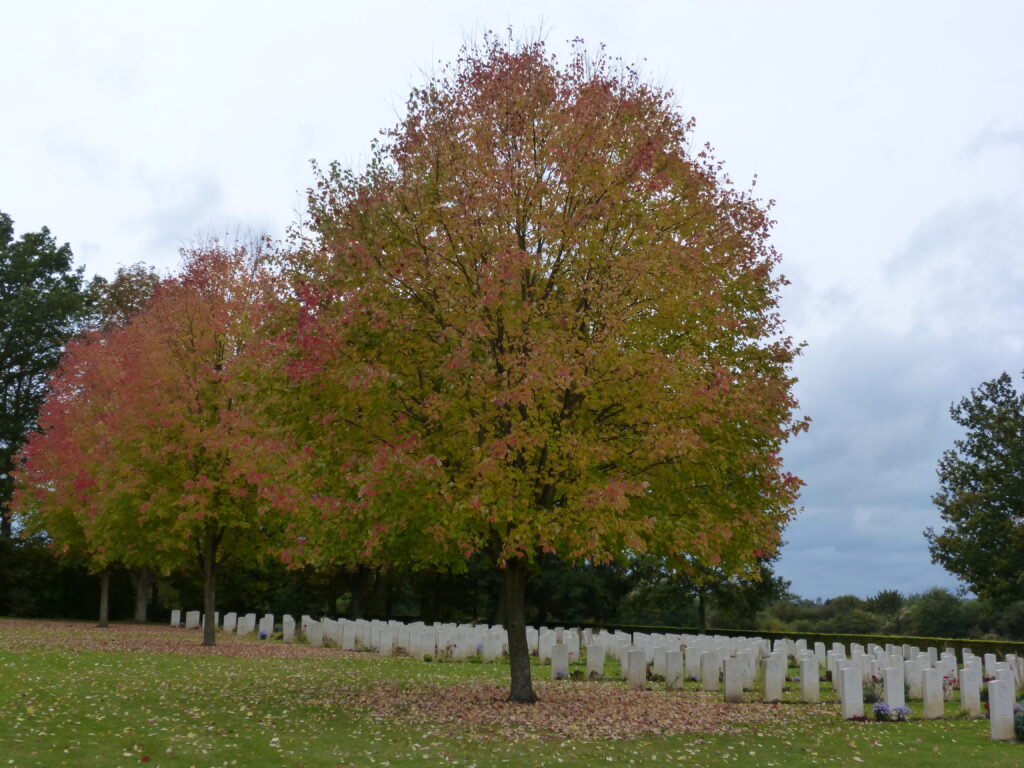
We had seen a few of these in various travels but had never visited one. An informational pamphlet here read “Hotton marks the limit of the German advance in the Ardennes counter-offensive of December 1944/January 1945. Most of the soldiers buried here died in the operations to hold and drive back the Germans. Of the 667 war burials, 340 are soldiers, 325 airmen and 1 a war correspondent; 527 are British, 88 Canadian, 41 Australian, 10 New Zealand and 1 Polish.” (I know the first set of numbers add up to 666 and not 667. The driving tour pamphlet we had says there is a Belgian soldier buried here who fought with the 53rd Welsh Division, so that may account for the other person.)
The cemetery had a list of names of everyone buried there and Sean noticed there was a soldier by the name of Gilligan (my maiden name) there. He was Private Gerald Gilligan, 1/5th Bn., Welch Regiment. He was the son of Patrick and Kathleen Gilligan of Eccles, Lancashire and he was killed at age 18 on January 4th, 1945.
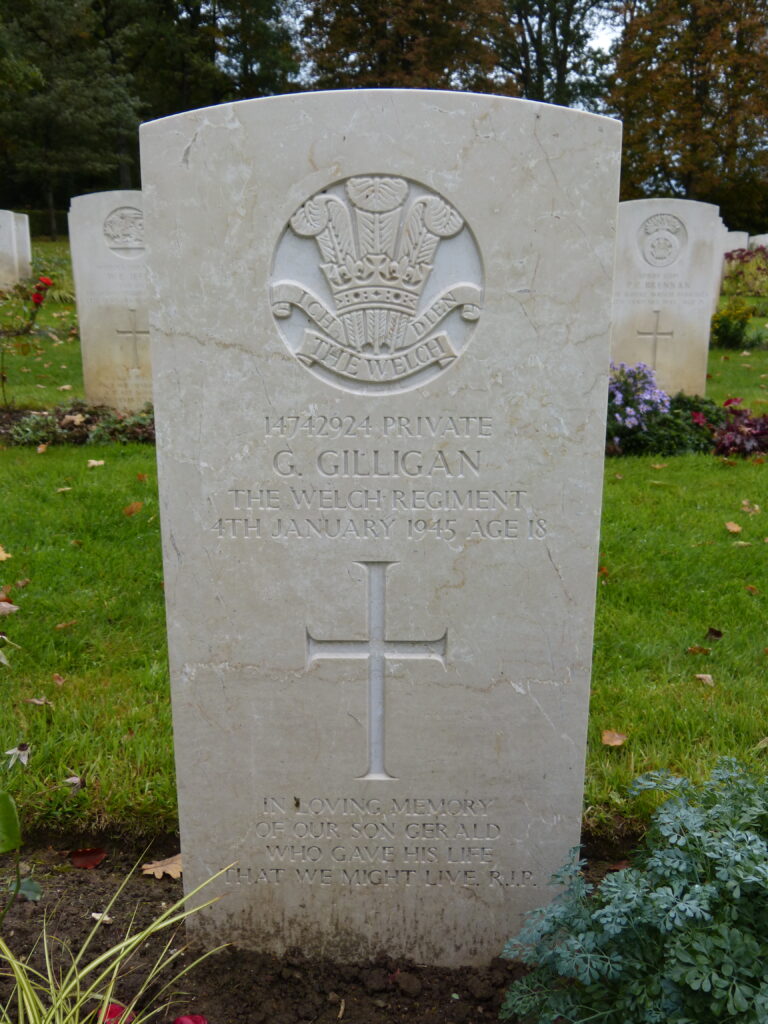
The engraving at the bottom of the headstone says “In loving memory of our son Gerald who gave his life that we might live. R.I.P.”
Most of the headstones had something engraved at the bottom and they really brought me to tears. Here’s what some of them said:
“How we miss you dear son. God be with you till we meet again. Rest in peace, Mum & Dad.”
“I often wonder, son, how you died with no loved one near to bid you a last good-bye.”
“Our only laddie.”
“R.I.P.. Sadly missed. Mum, Dad, Brothers, Sister-in-Law, Wee Mae and Wee Margaret.”
“In dearest memory of my beloved Jack. My only child. Mother.”
“In loving memory of our first son who gave his life for his faith.” (That one was on a Jewish headstone.)
An engraving in a little building with benches in it read “The land on which this cemetery stands is the gift of the Belgian people for the perpetual resting place of the sailors, soldiers and airmen who are honoured here.”
After leaving the cemetery, we went in search of this tank.
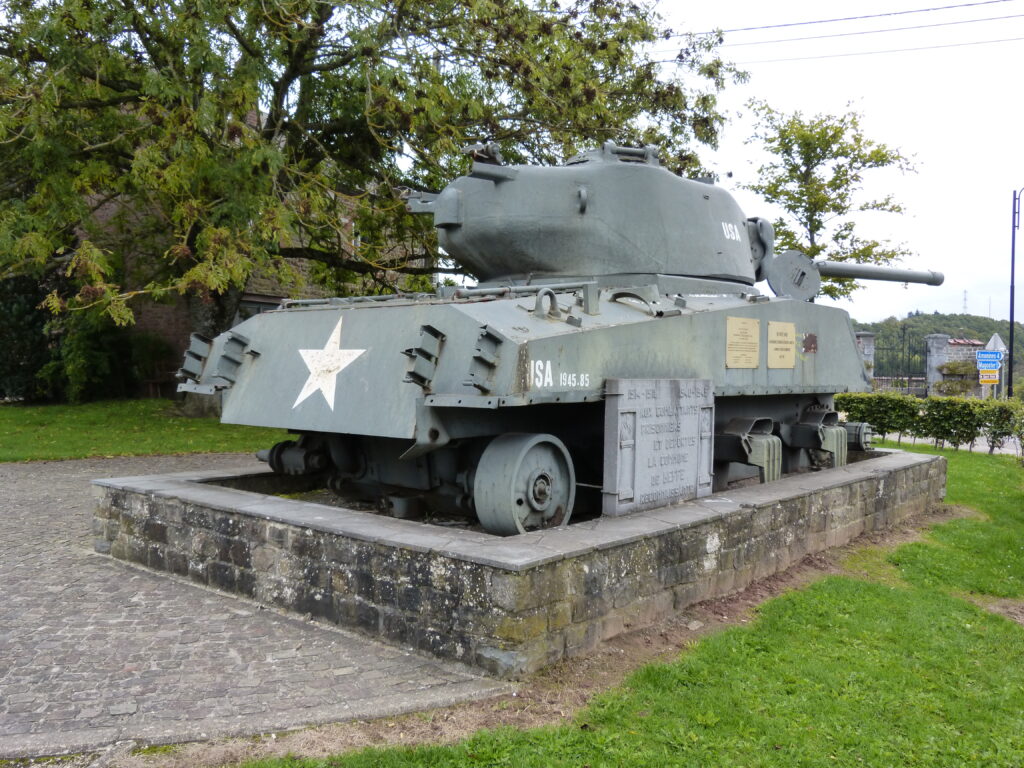
Not to make light of anything, but we had to see this tank, which is dedicated to Task Force Hogan. The task force was named after Colonel Hogan of the 3rd US Armored Division. Fans of a certain 1960s TV show will get the reference.
The tank was in the town of Beffe, and as we were leaving town I noticed this restaurant sign. If you don’t get it at first, say it out loud.
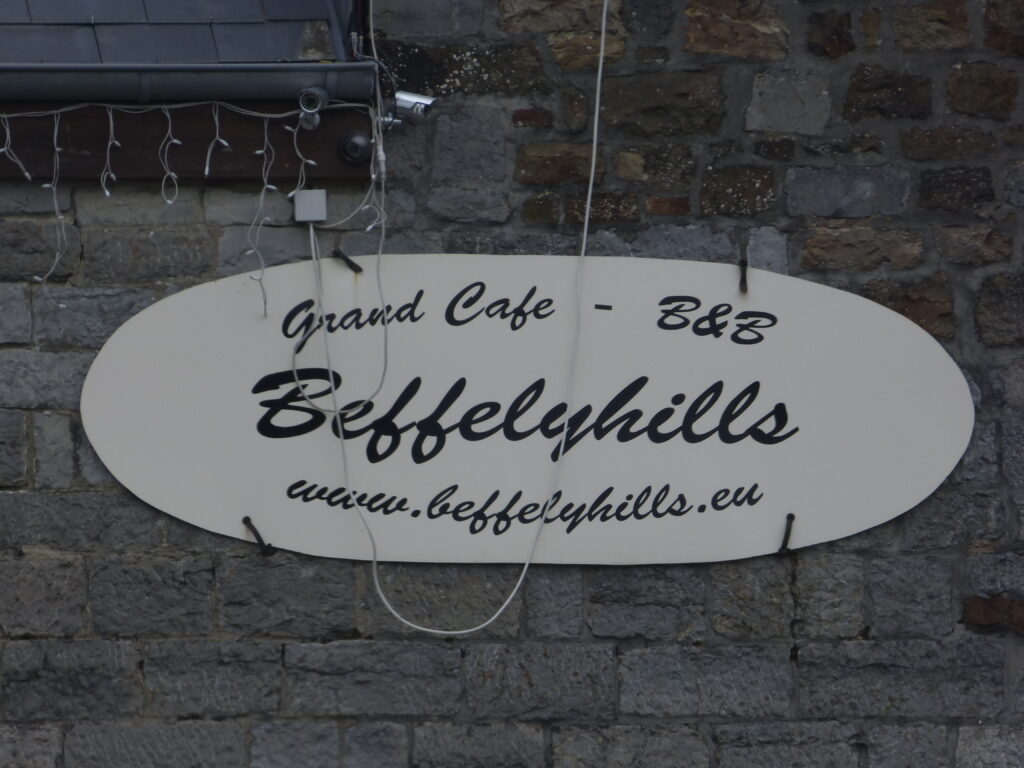
Our next stop was the town of Wibrin to see this Sherman tank.
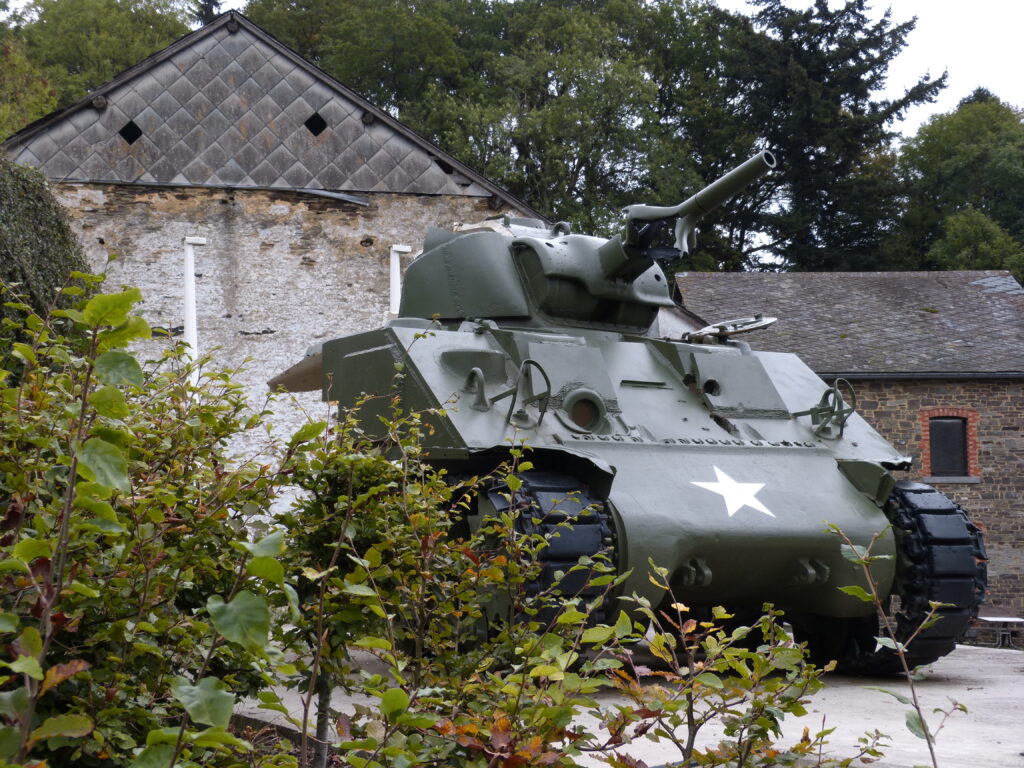
Notice the split gun barrel, which was probably destroyed by the Americans themselves before abandoning it. The tank was saved by the people of Wibrin after it had been purchased by scrap metal dealers. As you can see, the tank had already begun to be cut up and just the front part of it remains.
And here’s Sean standing inside the tank and peeking through the top of it.
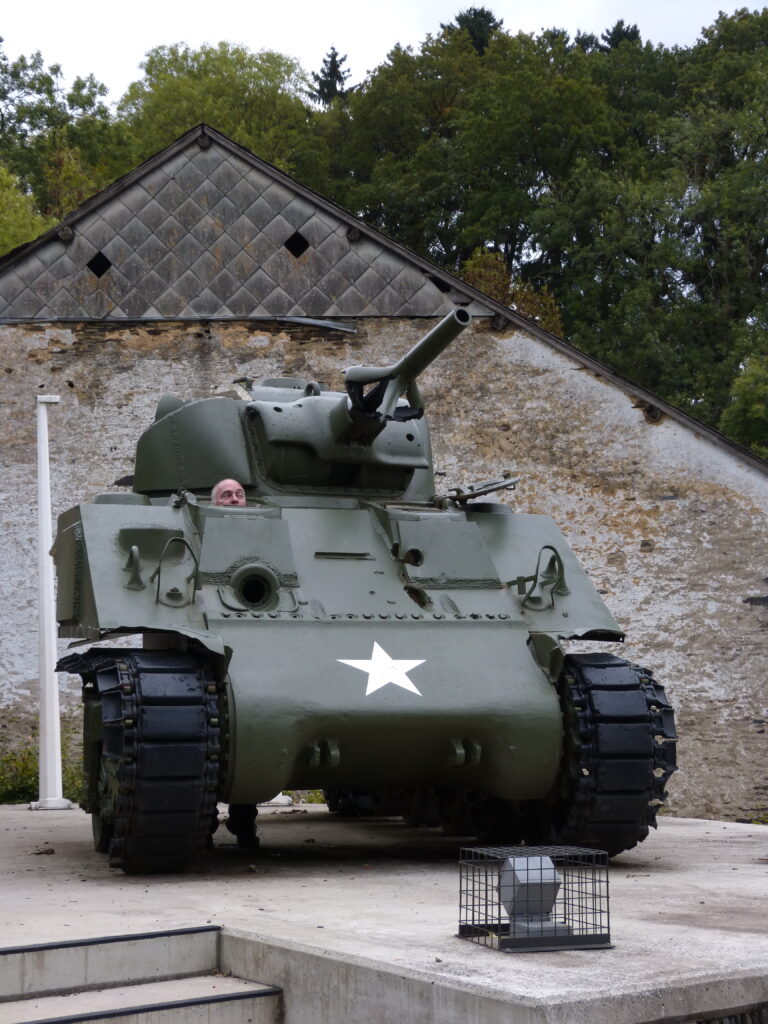
As we tried to continue on our way, these cats just did not give a shit that we were trying to drive down the street in which they were sitting. They’re bad-ass.
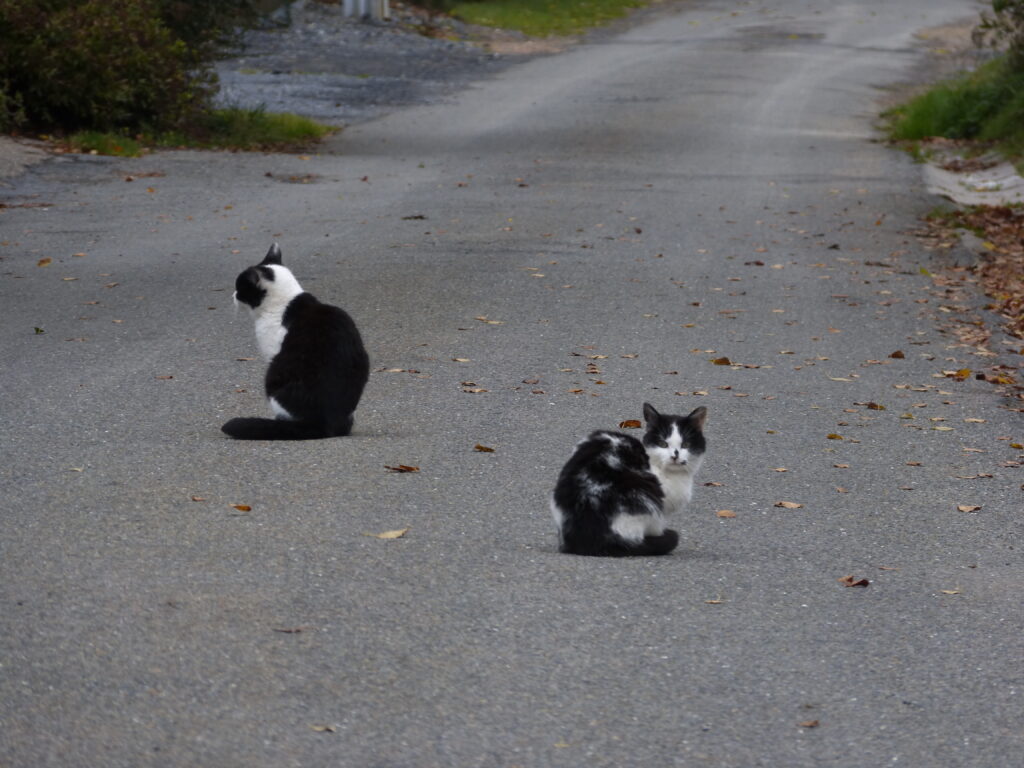
Our next stop was another visit to the town of Houffalize. This awesome play area is in the back of a place called “Houtopia”. Our driving route brochure says it’s also called “The World of Children”, a recreational, games and learning centre enabling children to learn their rights and responsibilities…..” Hmm.
And this is hideous piece of public art.
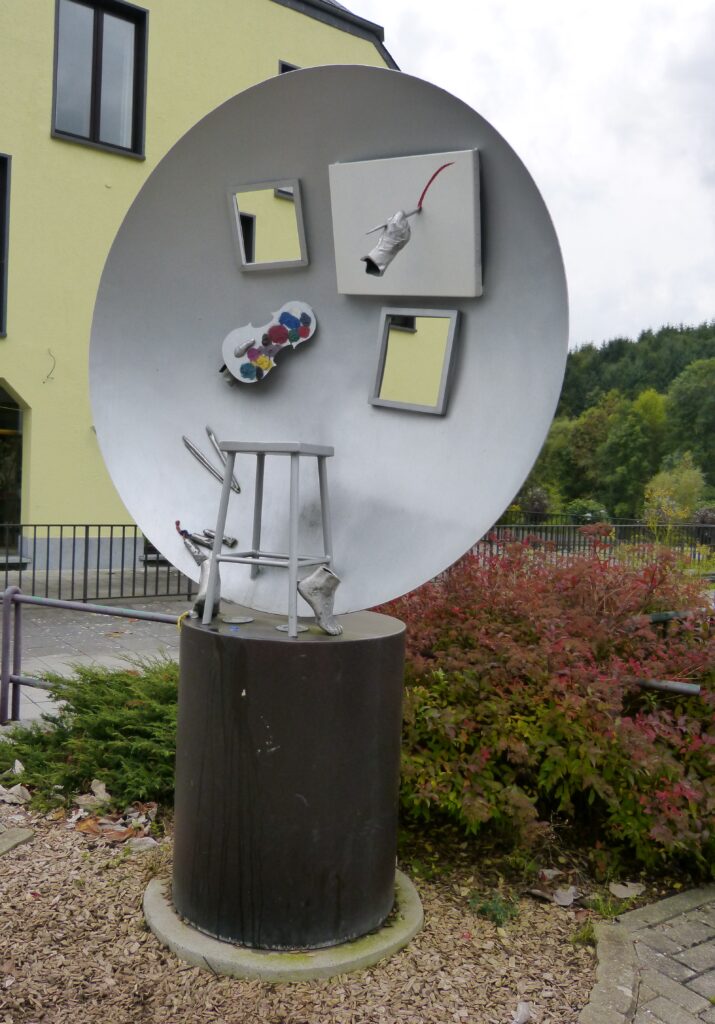
I don’t get it. I much prefer this:
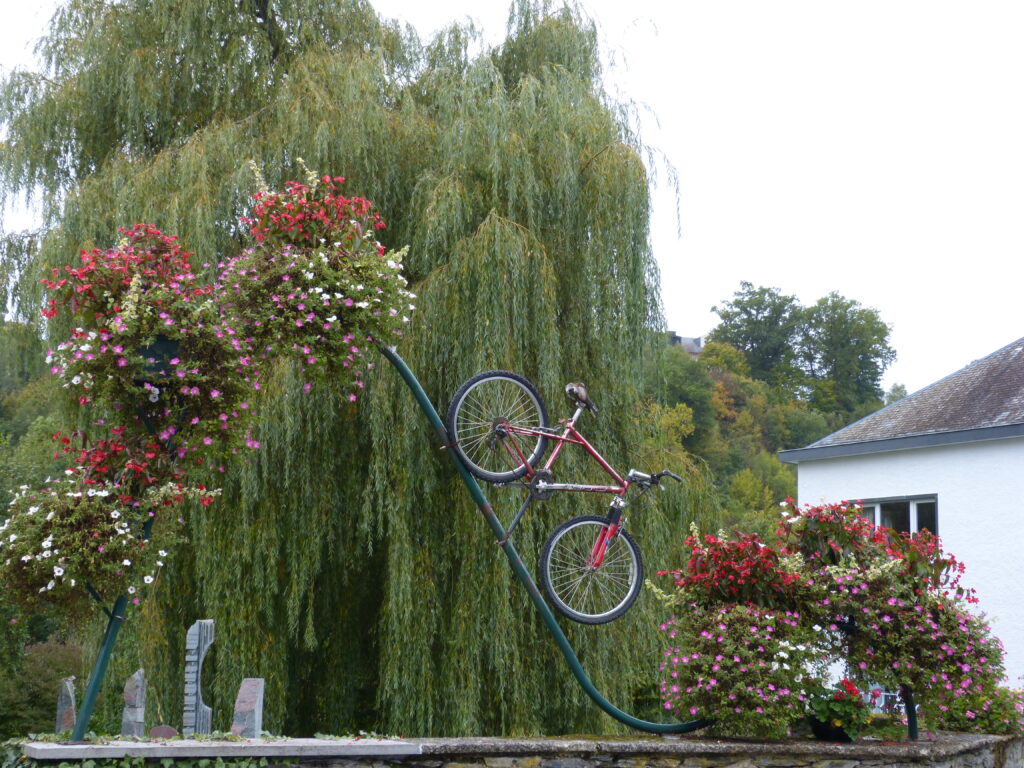
But what we really came back to Houffalize for was to see this:
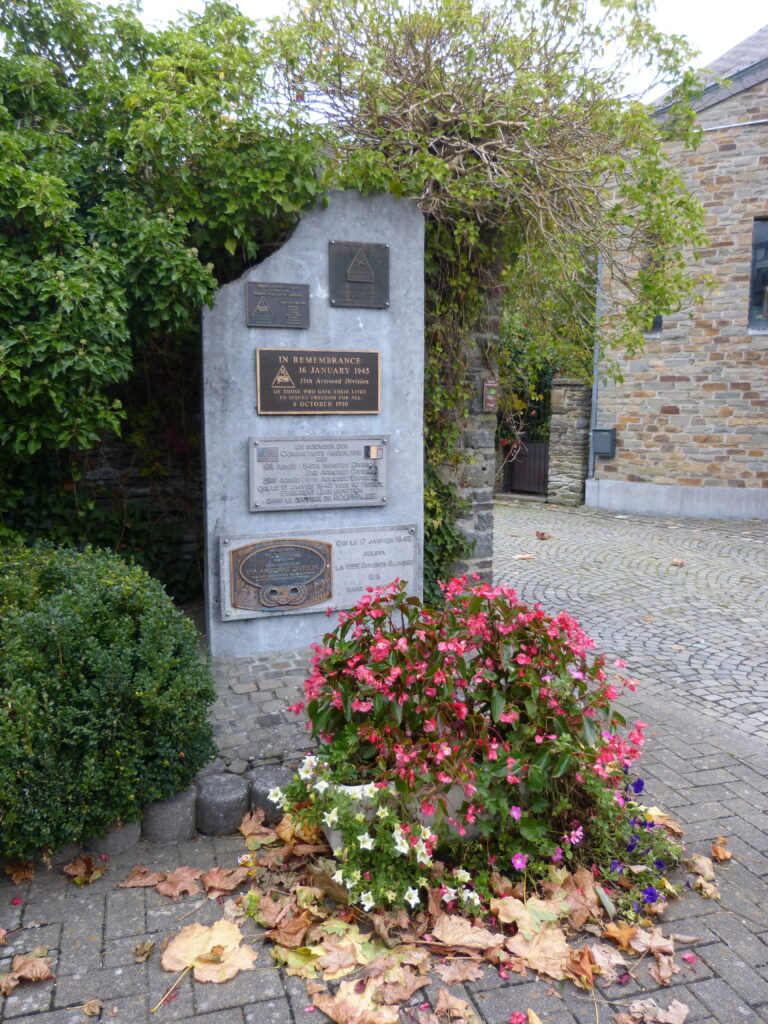
According to the brochure, this is a “Monument to the link-up on 16 January ’45 of the troops of Patton’s 3rd Army with those of Hodge’s 1st Army.”
We also wanted to see this:
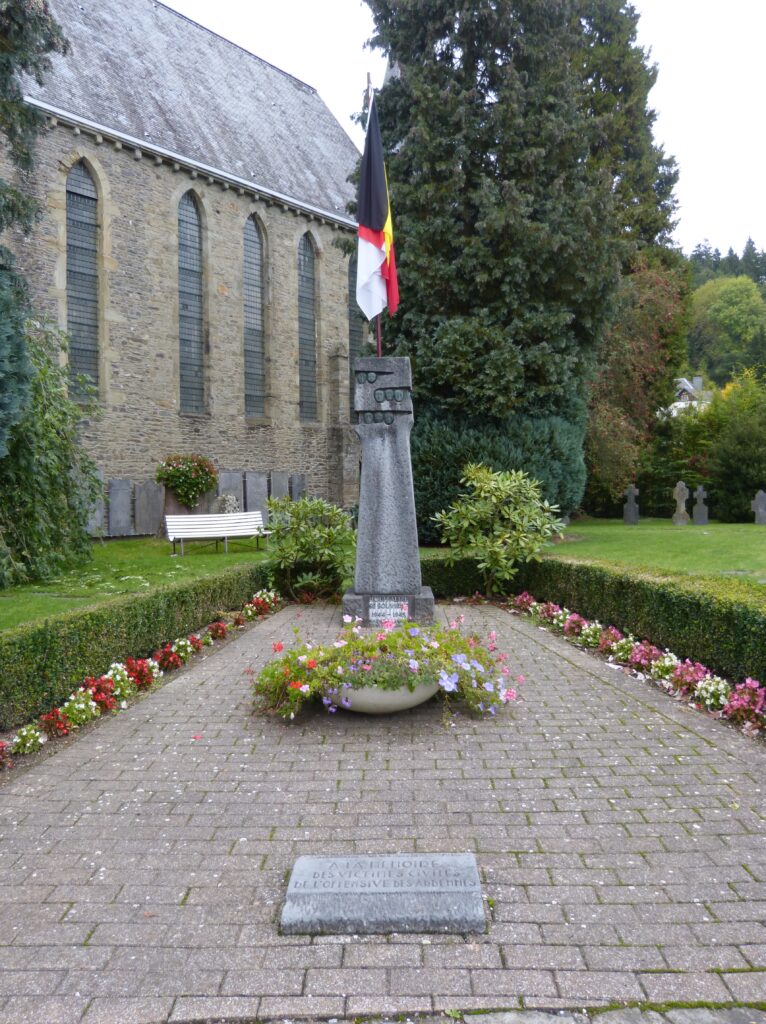
The brochure says it’s a “Memorial dedicated to the civilian victims of the town, which received the ‘Croix de Guerre’ with bar for exceptional courage during the bombing and the fighting for the liberation.”
On the way out of town we saw this Statue of Pogue.
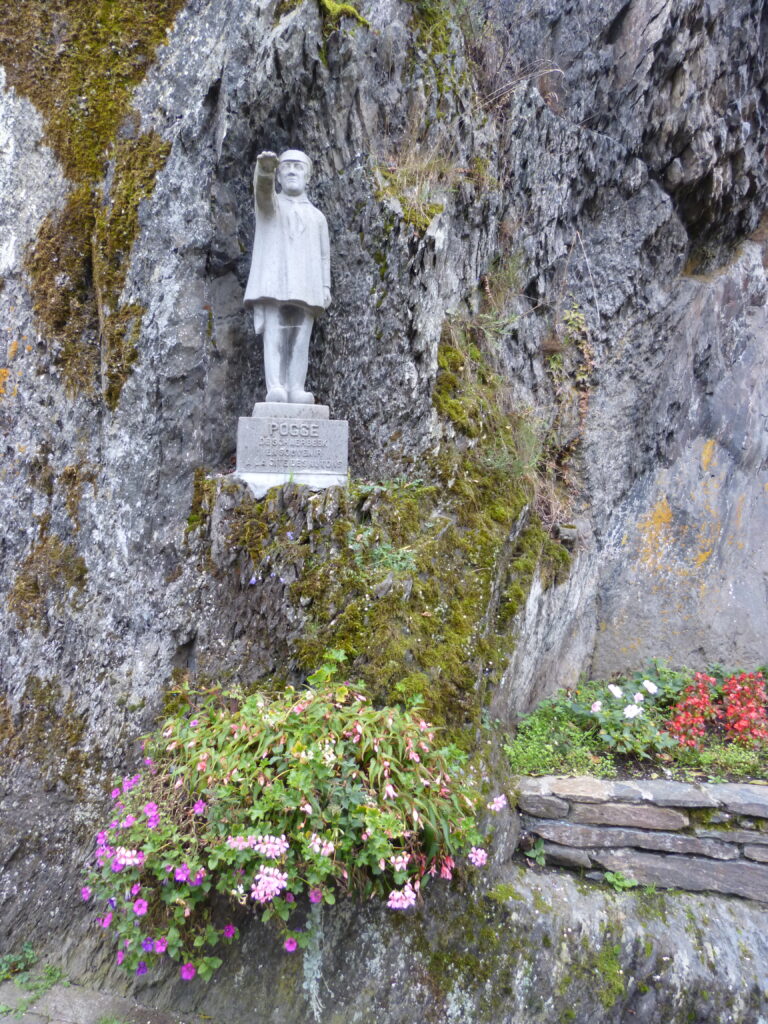
He’s apparently a Belgian folklore character. Sean pointed out that his pose is oddly reminiscent of a Nazi salute.
That was pretty much it for Day 3 in Bastogne.
The next day we headed home and this is the last photo I took for the trip on our way out of town:
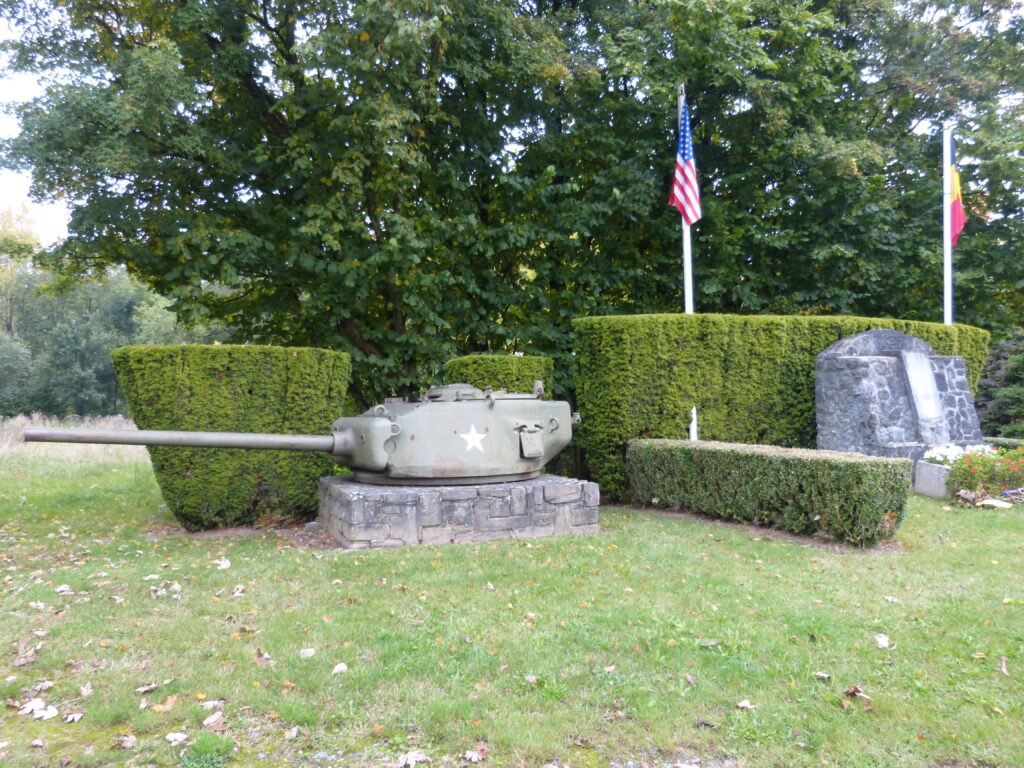
It says “This monument has been erected by the grateful town of Bastogne to the memory of Ernest Glessener the first G.I. killed on this spot on September 10, 1944 after having destroyed a German tank.”
There were several other WW II sites that we visited along what’s called the Historical Route. This route was not in our driving book brochure. The first site on the route is at McAuliffe Square and there are 15 sites in all. At each site is a sign with information about what you’re seeing and/or what took place there during WW II, along with information about how to get to the next site. I’ll posts a separate short blog about that drive.
I was really pleasantly surprised by this trip. Although I’m grateful for the opportunity to visit so many WW II sites in Europe, I thought 3 nights in one area might be too much for me and that Sean would find much more to interest him than I would to interest me. I was happily mistaken and could have spent several more days here so we will add this to the ever-growing places of places we’d like to visit again.

